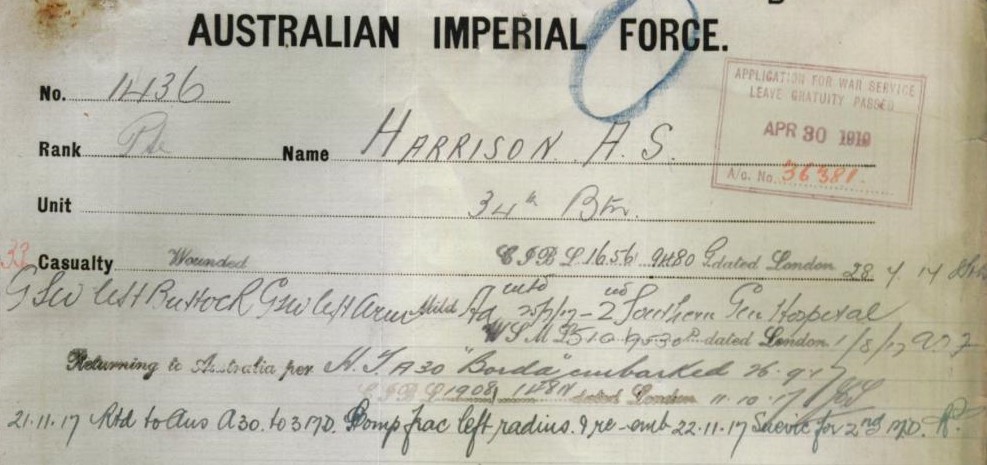34th BATTALION AIF - Concentration Camp Guard.
Private: 1436 Aubyn Sydney HARRISON.
Born: 25th August 1895. Orange, New South Wales, Australia. Birth Cert:
Married: 1926 Cessnock, New South Wales, Australia. Marriage Cert:13975/1926.
Wife: Mildred Ann Harrison. nee: Luscombe. (1897-...) Born at Nowra, N.S.W.
Died: 15th October 1976. New South Wales, Australia. Death Cert:107149/1976.
Father: James Harrison.
Mother: Ellen Harrison. nee:
INFORMATION
Aubyn Sydney Harrison enlisted with B Company 34th Battalion AIF on the 19th February 1916 an was allocated to B Company and was an original member of the Battalion. He went into camp at the Rutherford Army Depot and left Farley Station with the 34th Battalion on the 1st of May for Sydney. On the following morning, 2nd May 1916 the men embarked on the transport HMAT A20 "HORORATA" and sailed at 4:00 pm".

H.M.A.T. A20 "HORORATA
Devonport was reached on the 23rd June, the Battalion disembarked at Plymouth at 1:00 pm and en trained during the afternoon for Amesbury, arriving at midnight and marching to hutments at No: 1 Camp, Larkhill. Here the Battalion settled down to hard training, which included Route Marching, Trench Digging, Bomb Practice, Musketry and General Camp Routine. Later the Battalion moved to the No: 25 Camp and finished off their training, which included six days' battle practice and field work at the Bastard Trenches.
The 34th Battalion left Lark hill on the 21st November and en trained at Amesbury for Southampton, embarking on the S.S "Arundel". The transport section left by S.S. "Princess Victoria". The Battalion arrived at Le Harve, France on the 22nd November 1916. Disembarkation commenced at 8:00 am and the Battalion marched to No;1 camp on the Hill, arriving at 2:00 pm. The men carried heavy loads, in some cases amounting to miniature Q.M.' Stores. The march over cobblestones was very tiring, notwithstanding the many route marches which had been carried out at Larkhill. However, after bathing their feet and receiving treatment, as well partaking of a good meal, some spent a comfortable night.
6th June 1917.
BATTLE OF MESSINES
(1) At 10 pm on the 6th June 1917, the Battalion left its billets fully equipped for the assembly Trenches. The order of march being "D", "A", "C" and "B" Companies. All went well until just before reaching Gunners Farm, where the enemy was putting a number of Gas Shells over and Masks had to be put on. Ploegsteert Wood and the back area were receiving particular attention. All Companies were greatly delayed of the amount of Gas in the Wood, which resulted in a number of men being gassed on the way up and many others were completely exhausted. A number of men lost there way in the darkness and smoke. Many could not see at all and had to be led back by there comrades. I many cases it was the blind leading the blind. After a gruelling March, the first arrivals reached the Assembly Points 30 minutes before Zero Hour, while the last company arrived only 10 minutes before Zero.
On the 7th June, seven seconds before Zero Hour, which was 3.10 am, four Miles on our front were fired. There was a violent swaying as if an earthquake had taken place and the men in many instances were thrown together. The sky was brilliantly illuminated by the explosives and terrific Artillery fire, the sound of which could not be heard over the intense Machine Gun Barrage. The men left the Trenches immediately and there were a number of casualties on the parapet owing to the heavy enemy Barrage. The supports were also being shelled and the Reserve Company ("D") suffered considerable losses. The weather was hot and sultry and every one felt the tiring march.
The Battalion passed through the 35th Battalion in the vicinity of the enemy's original Front Line, near Ulsters Switch. The enemy fire had been very severe up to this point and many men were lying here. A halt in our Barrage gave the Company Commanders an opportunity of Checking their Compass Bearings, defining their limits, and getting into position for the next advance. At the left of the Barrage a fine assault in complete waves was made. The men gained their objective in fine style behind a perfect Barrage and commenced consolidating their position. The mopping up of the Trench System was soon accomplished and many of the enemy were killed in their Dugouts. By 5.30 am fair cover had been obtained on the Consolidation Line. At 6.30 am Enemy Machine Guns were located in a rebout in "Uncertain Trench" and heavy Artillery was brought to bear on them with good results. By 7.30 am the Black Line was down to two thirds of its depth and linking up by Companies and Platoons were in progress. The enemy was seen moving along "Uncertain Trench" and also reports were received from the 33rd Battalion that the enemy was massing 1,000 yards in front. Reports of enemy movement continued throughout the early part of the morning, but Artillery co-operation helped to disperse the tendency and during the day no organised counter attack was attempted.
At 8.30 am the Line was well dug along the Front and affording excellent protection for the men. By 9.30 am only one gap remained between "A" and "B" Companies in the full length of the consolidation of the "Black Line" to the River La Douve. The Trenches being now well down, widening and sandbagging were now in progress and at 11.30 am showed very plainly in an Arial Photo as a good defensive Trench. There were repeated enquiries for water from the Front Line. Carrying Parties were suffering heavy casualties and were completely knocked up with the long distance.
At 1.40 pm Captain: Arthur Sidney WHITLOCK with "D" Company advanced to the Green Line, without Artillery support, owing to an alteration in the Zero Hour not reaching him. At 2.45 pm he reported by Runner that, having waited 30 minutes and no Artillery Barrage as arranged have been put down, he had advanced to the Green Line and was consolidating. by 7.30 pm all Companies reported that their positions were well consolidated. Just before midnight Captain: Arthur Sidney WHITLOCK was killed between the Green and Black Lines, and Captain: Robert Joseph STEWART took command of "D" Company. Patrols under the Scout Officers were sent out during the night and encountered enemy Patrols which were dispersed. A number of enemy patrols were also killed by our Machine Gun and Lewis Gun fire earlier in the night. At 5.00 am on the 8th June an enemy Plane over, flying low and inspecting our new position.
Our casualties to date had been 8 Officers and 236 other ranks. Captain: Arthur Sidney WHITLOCK and Lieutenant: 584 Leslie William Roy WARNER K.I.A. Lieutenant's Lieutenant: William Walter MATTHEWS Lieutenant: Hector Reginald McLEOD, Lieutenant: Bruce Gray McKENZIE, Lieutenant: Benjamin Greenup BRODIE, Lieutenant: Thomas Clifton PITTAWAY and Lieutenant: Frederick Winn WALKER wounded.
During the morning the enemy put over a heavy Barrage of 7.7's and 4.5's. Captain: Robert Joseph STEWART sent a message by pigeon that our own Heavies were dropping a few Shells short and doing some damage to our own Trenches and causing a few casualties. Several messages were sent back but it was some time before the matter was rectified. At midday enemy Machine Gun Fire from the vicinity of Potterie Farm, about 300 yards from our Front, was very troublesome. At 4.00 pm our Artillery opened up a heavy bombardment which continued for four hours. This was replied to by the enemy at 8.30 pm and was particularly heavy north of La Douve. Ten minutes after this opened all communication lines were cut and messages were sent on the Power Buzzer. By 10.40 pm everything had become normal and the night was fairly quiet.
On 9th June 1917, Lieutenant: Clarence Smith JEFFRIES. with a Patrol of 50 Other Ranks left our Trenches at 4.00 pm with the object of reconnoitring Potterie Farm. This Patrol came under heavy Machine Gun fire and on returning reported the position was fairly strongly held. Lieutenant: Clarence Smith JEFFRIES. was wounded, 2 Other Ranks killed and 3 wounded.
Private: 192 Edward Rolfe "Robert" SPINKS. Killed in Action.
Private: 2640 Clive William QUINN. Killed in Action.
On the night of 12th June the Battalion moved out to Vauxhall Camp and here reinforced by reserve men from Morbecque. The whole operation had been most successful, in spite of the difficult approach March, caused by the wearing of Gas Masks and the darkness of the night. About 3.30 am an unusual occurrence happened when one of our Planes, flying low for observation, was struck by one of our Shells and was cut in halves. During the whole period rations were taken up as usual, the limbers and Carriers being constantly under heavy fire. Many brave deeds were performed and a number of Officers and men were recommended for decorations which were in many cases awarded later. Total casualties were 10 Officers and 399 Other Ranks.
On 14th June the Battalion moved to billets near Vieux Berquin for rest and training. The next day the Corps Commander, Lieutenant General: Sir Alexander John GODLEY inspected the Battalion at Doulieu. Captain: Charles Edwin Woodrow BEAN Australian War Correspondent, was also present. The following day General: Herbert Charles Onslow PLUMER, Army Commander, interviewed the Officers and addressed them. The weather was fine and the men had a good time bathing, writing letters and resting, while reorganization and training was carried out.
On the 21st June the Battalion moved back to Vauxhall Camp and the following day went into tents at Neuve Eglise and relieved 1st Wiltshire Regiment. Training, sports and other competitions were carried out. The weather was fine and enemy planes were very busy strafing our Observation Balloons and the Artillery on several occasions shelling Neuve Eglise. Whilst Here the DUKE of CONNAUGHT held an inspection at Bailleul, the Battalion being represented by Captain: Robert Joseph STEWART Company Sergeant Major: 225 Thomas Brown NORMAN. and 3 Other Ranks.
On 27th June a Sports Day was held and the enemy livened up the proceedings by setting fire to four of our balloons at the one time. During the evening the Cooee's gave a concert. At 9.00 pm the same evening the Battalion marched to the rear of Middle Farm and relieved the 36th Battalion in reserve. From here the Battalion supplied Working Parties during the night time. The enemy shelled continuously and there were a number of casualties. The Transport had a very difficult time taking up the Rations along the track which was being continuously shelled, especially in the gully near Railway Line.
On the 1st July about 4.30 am the Transport came under heavy shell fire and Sergeant: 1482 Timothy "Tim" Daniel MALONE who was in charge, called a halt for a time. When things appeared a little quieter he decided to make a dash for the Ration Dump. When about 300 yards from it a heavy shell struck the Transport, killing Sergeant: 1482 Timothy "Tim" Daniel MALONE and a store man and wounding three others. The Limber was upset into a hole and the Mules killed. The wounded having been taken back, the Rations were delivered to the Battalion, good work being done by Private: A J TAYLOR. The weather was fine but the ground was a mass of Shell Holes. Continual trouble was experienced in transporting Rations, as the enemy appeared to have good observation and always seemed to open fire on any movement. Carrying Parties had long trips to make and heavy loads to carry and were under constant Shell fire. Tracks were charged but conditions did not improve and numerous casualties were sustained nightly. Lieutenant: Henry Cecil Llewellyn BENNETT. who had charge of the Carrying Parties, did good work under trying circumstances and by his coolness set the men a fine example.
On the night of 3rd July the Battalion relieved the 33rd Battalion at Middle Farm. Lieutenant: Harold Wydham LILJA joined here with a number of reinforcements. The enemy was raining Shells on this position, but it was very noticeable that a large representation were "duds", as many 15 in succession. The Battalion was relieved by the 36th Battalion on 6th July, and on 7th July during the afternoon Lieutenant General: Sir Alexander John GODLEY held a review at Hillside Camp. Captain: Robert Joseph STEWART and Captain: Herbert Henry PERCY were decorated with the Military Cross, While 1 Distinguished Conduct Medal and 11 Military Medals were presented to Other Ranks.
Captain: Herbert Henry PERCY Military Cross
Captain: Robert Joseph STEWART Military Cross
Lance Sergeant: 1070 Donald Francis BERMAN. Distinguished Conduct Medal.
Rain and Heavy Shelling made the conditions bad, but the weather cleared later and Air Fights became more Frequent, with sometimes as many as 30 enemy Planes in one formation. On 12th July the Battalion relieved the 44th Battalion in the Front Line. This was carried out with great difficulty owing to the heavy enemy Artillery Fire. On the night of 13th July the enemy opened up a heavy bombardment on our Front Line. Captain: Robert Joseph STEWART M.C "A" Coy, sent up the S.O.S. Signal and a good response was made by our Guns, but enemy movement followed. However, early in the morning many Bombs were thrown into "A" Company's Trenches from a Strong Point opposite "Gapaard Avenue".
The Trenches were very wet and muddy, with water in some places two feet deep. Ration Carriers had considerable difficulty in getting through. Duckboards were floating about in the Trenches. Rain continued to fall and conditions became worse, making the Trenches miniature canals. Heavy shelling was put over by the enemy, day and night, around "Gapaard" and "Wellington" Avenues, also "Owl" Trench, causing great damage to our Trenches.
Our 4.5 Howitzers put up a four hour Barrage to destroy three enemy Strong Points, which were causing trouble to "A" Company by throwing Bombs and small calibre "Minnies" into our Trenches, with resulting casualties. A Raid was planned for the night, but as the Howitzer Barrage failed to destroy the Strong Posts, Captain: Robert Joseph STEWART M.C sent a message asking that it be postponed. However at 9.15 pm. instructions were received from Brigade to go on with the enterprise. At 10 pm. Lieutenant: 777 George Edward HODGES. and 45 Other Ranks with two Lewis Guns attacked the Strong Posts. Immediately the party left the Trench they were met with a Barrage of Machine Gun Fire, Bombs and Grenades, from these points. The men pressed on with great determination until Cinema Road was reached.
Here enfilade Machine Gun Fire was brought to bear on them by the enemy who, it was discovered, were standing shoulder to shoulder under good cover waiting to attack. Lieutenant: 777 George Edward HODGES. successfully arranged the withdrawal of his Party under difficult circumstances. At 10:58 the enemy heavily bombarded our Front and support Lines and gave every indication of an immediate attack. Captain: Robert Joseph STEWART M.C fired the S.O.S. and the answering Barrage prevented the development of the attack. Our casualties in this operation were 2 killed and 10 wounded. the Stretcher Bearers did some good work under heavy fire and succeeded in bringing in our wounded.
Private: 2333 William HUNT. Killed in Action 13th July 1917.
Private: 486 John Victor LODGE. Wounded in Action 13th July Died of Wounds 14th July 1917.
Private: 894 Alexander SNEDDON. Wounded in Action 13th July 1917.
The Battalion was relieved by the 36th Battalion on 17th July and moved to a position of support in "Huns Walk" and the Subsidiary Lines in from of Messines. During the process of the relief the enemy sent over a great quantity of Mustard Gas, which made the change over both difficult and most unpleasant. There were no serious casualties, but a number of men were slightly gassed. Shelling of this area continued during the night of 18th/19th July, with large quantities of both H.E. and Gas Shells. Also large formations of enemy Aircraft were constantly flying overhead.
Private: 1528 Edward BRYANT Killed in Action 17th July 1917.
From here Working Parties were supplied for the Front Line and Jumping Off Trenches. While holding this Sector, all "B" Company Cooks were killed. The Cook Houses were constantly under fire, as apparently the enemy was able to see the smoke issuing from them. Gapaard Avenue was also under constant Shell Fire, which caused many casualties. The whole of the Support area was under heavy fire from 5.9's and 4.2's also Gas Shells. "C" Company at Zareete was subjected to an intense Barrage for two hours and sustained a number of casualties. Owing to the continuous Shelling some of the men were beginning to suffer from Shell Shock.
34th Battalion Short History
Aubyn was Wounded in Action on the 18th of July during this action when he received a Gun Shot would to his Buttock and Left Arm and was evacuated to the Casualty Clearing Station before being transferred to be invalided to England on board the "Grantly Castle" where he was admitted to the 2nd Southern General Hospital at Bristol, England. Upon his discharge he was returned to Australia on the 26th September 1917 and discharged from the AIF on the 26th March 1918.

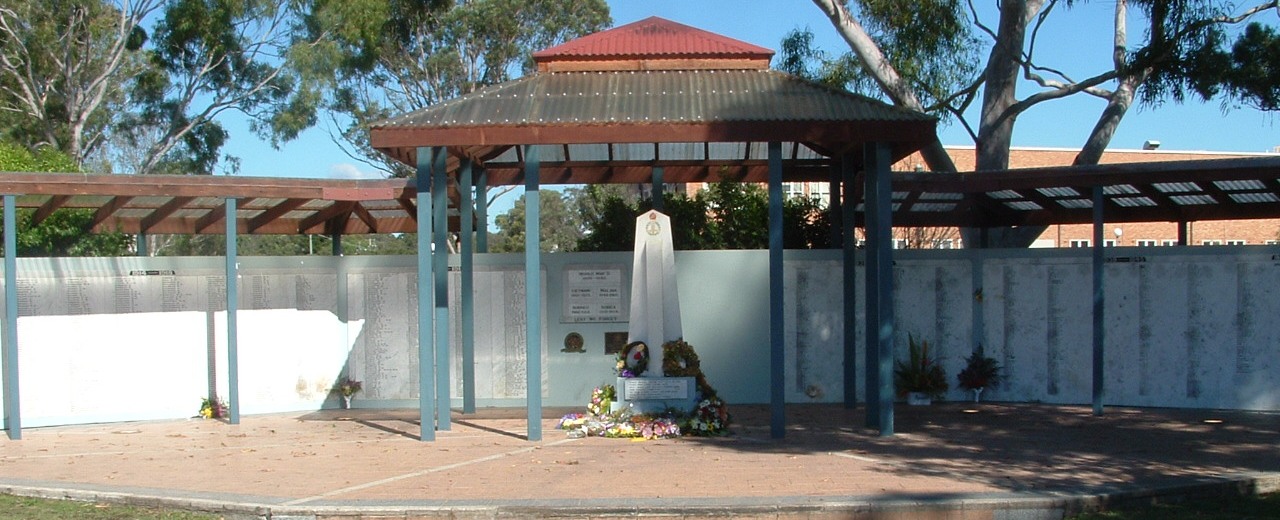
Cessnock War Memorial
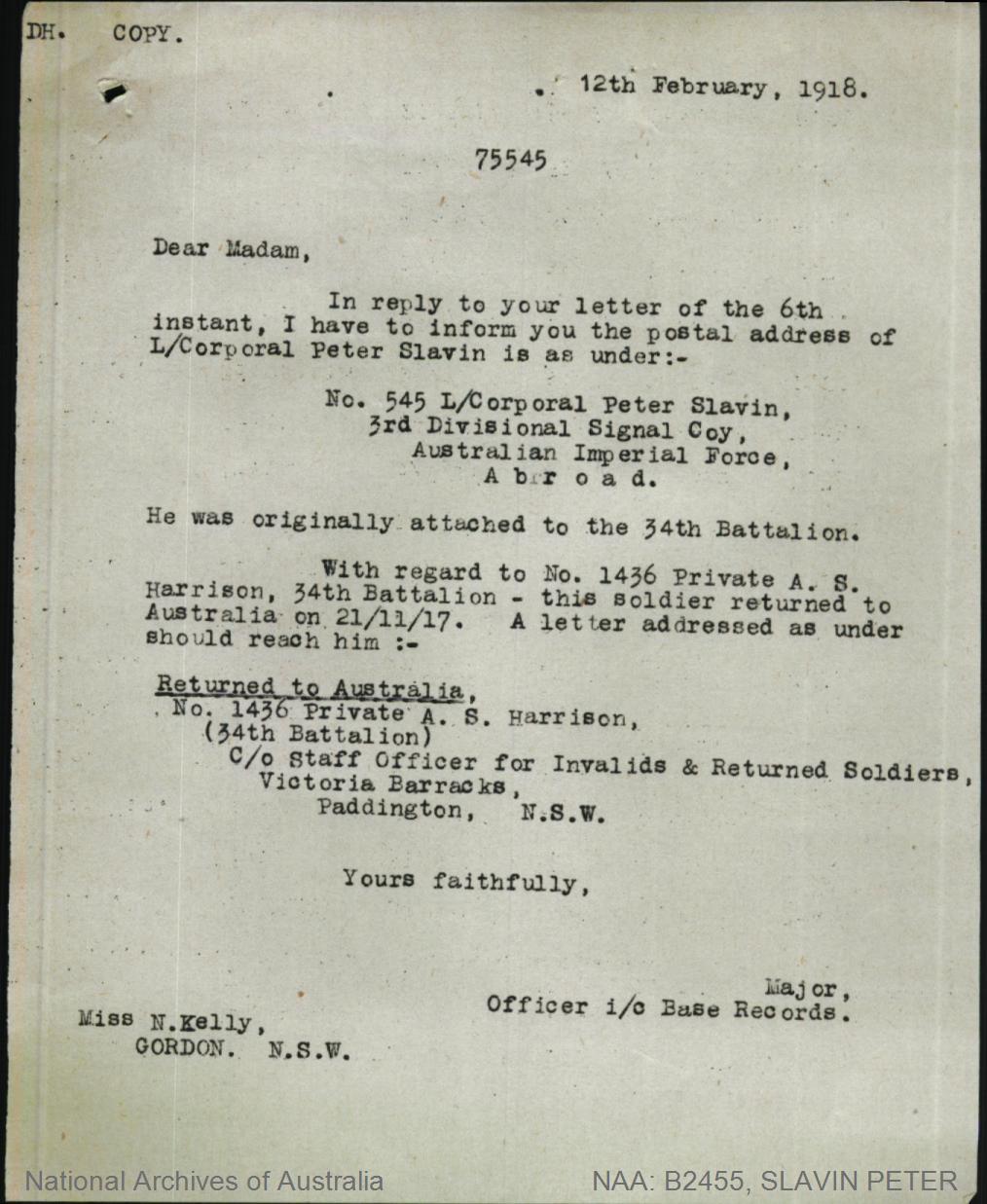
Lance Corporal: 545 Peter SLAVIN. 34th Battalion AIF
Family Information
Aubyn was a single 20 year old Engine Driver from Doyle's Estate, Cessnock, N.S.W. upon his enlistment with the AIF. Aubyn enlisted as a Concentration Camp Guard on the 28th May 1919 with the service number 3592 but was discharged on the 10th June 1919 as unfit for Corps Duties. His Returned for Active Service Badge was number 40450.
25th September 1925. Police Gazette.

DORIS WILSON (30) , summoned before the Cessnock Bench by Constable Booth, Cessnock Police, charged with maliciously shooting AUBYN SIDNEY HARRISON with intent to do grievous bodily harm, has been committed for trial at Maitland Session. Admitted to bail.
In 1935 Aubyn and Mildred lived at 44 Mayfield Street, Cessnock and Aubyn's occupation was as an Engineer. Aubyn was Cremated at the Beresfield Crematorium.
Military Records
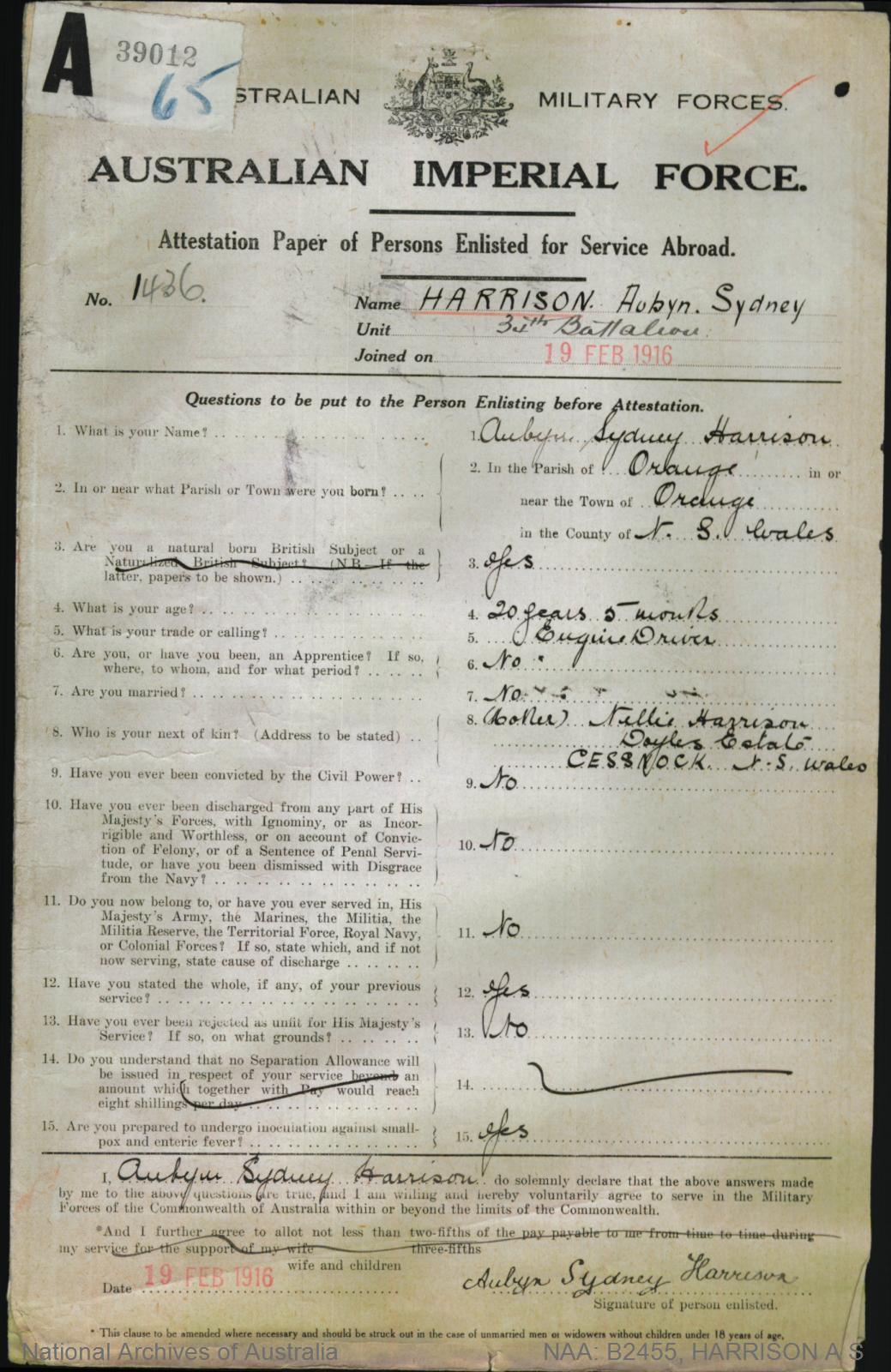
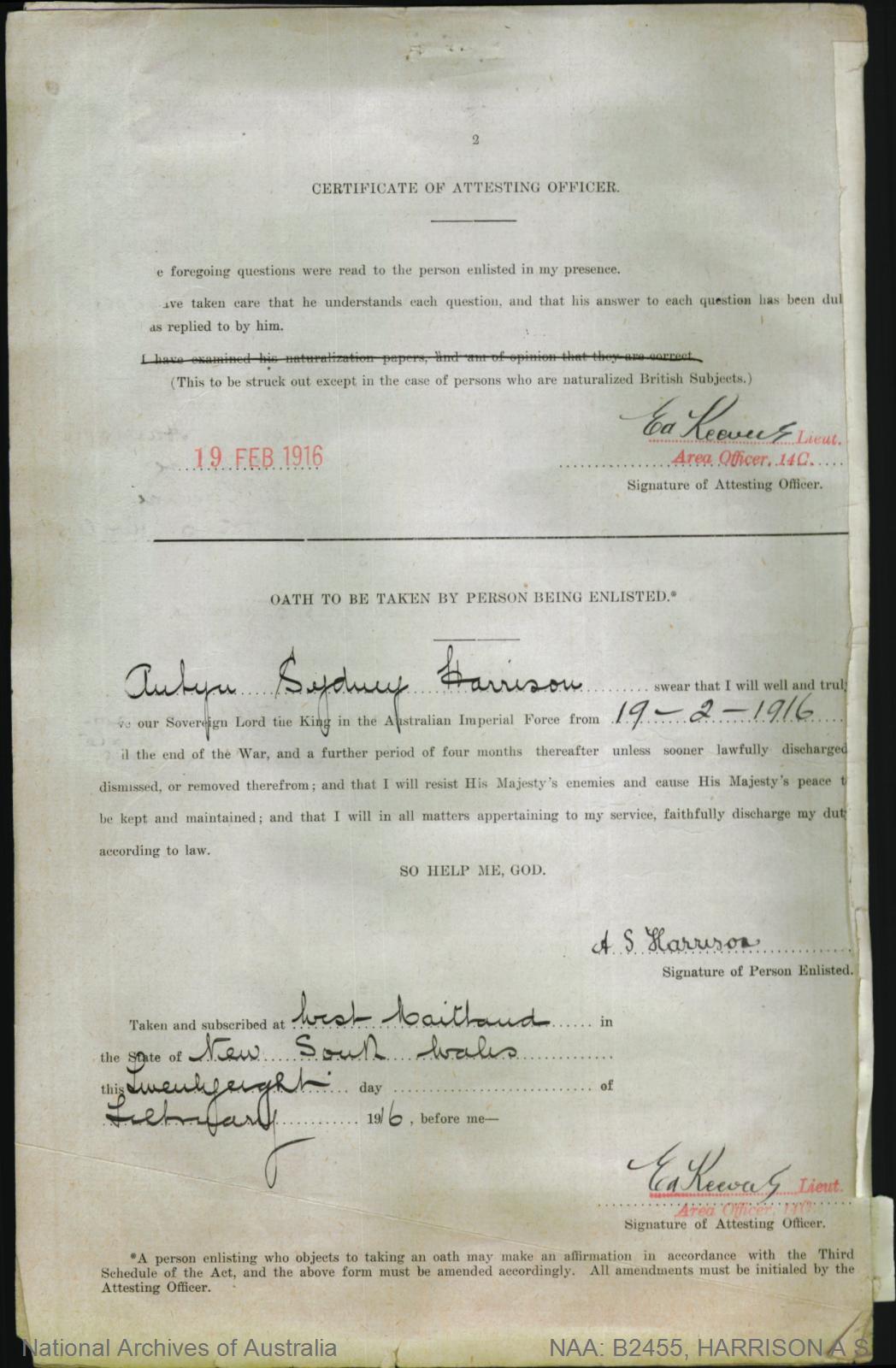
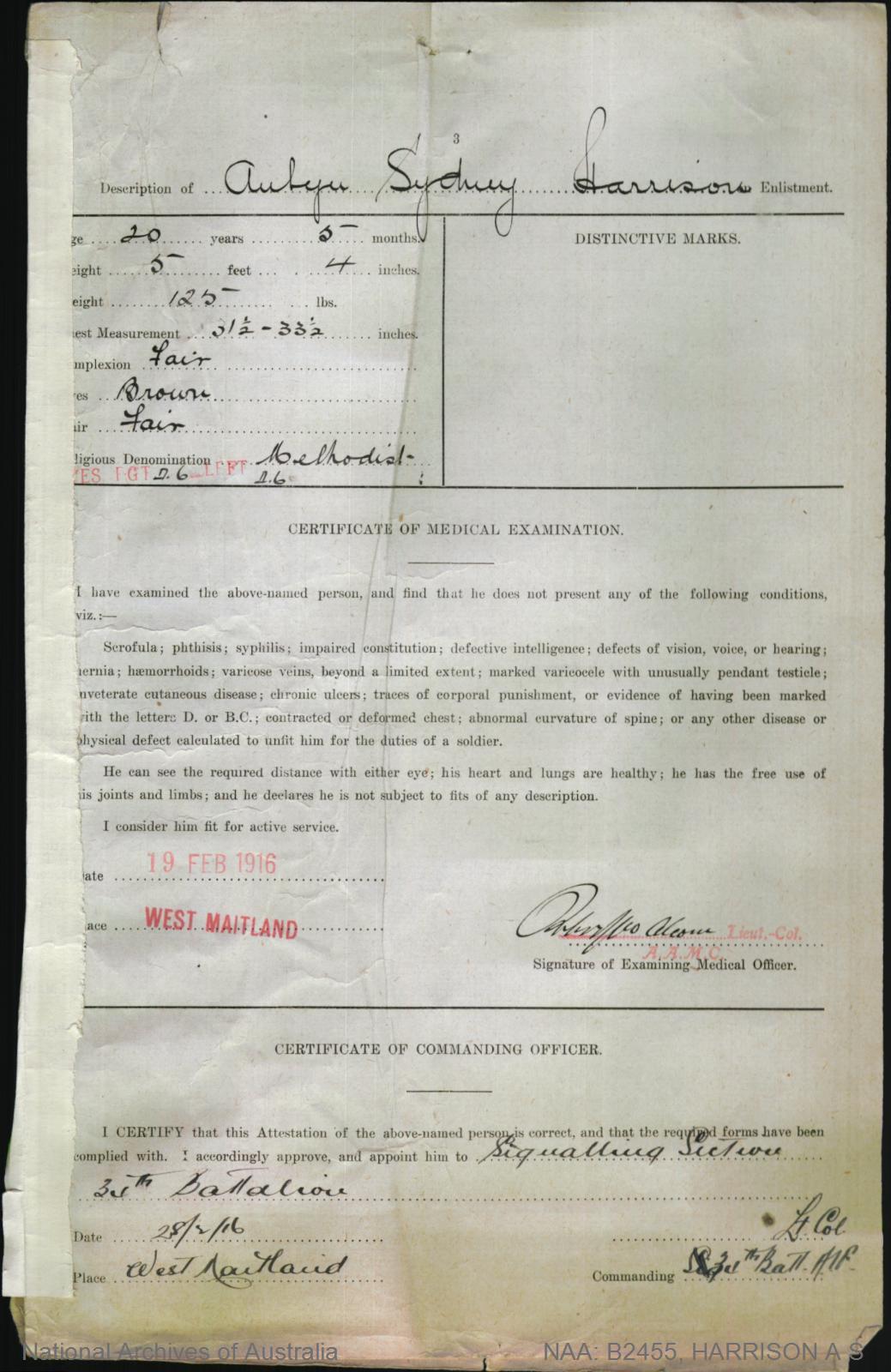
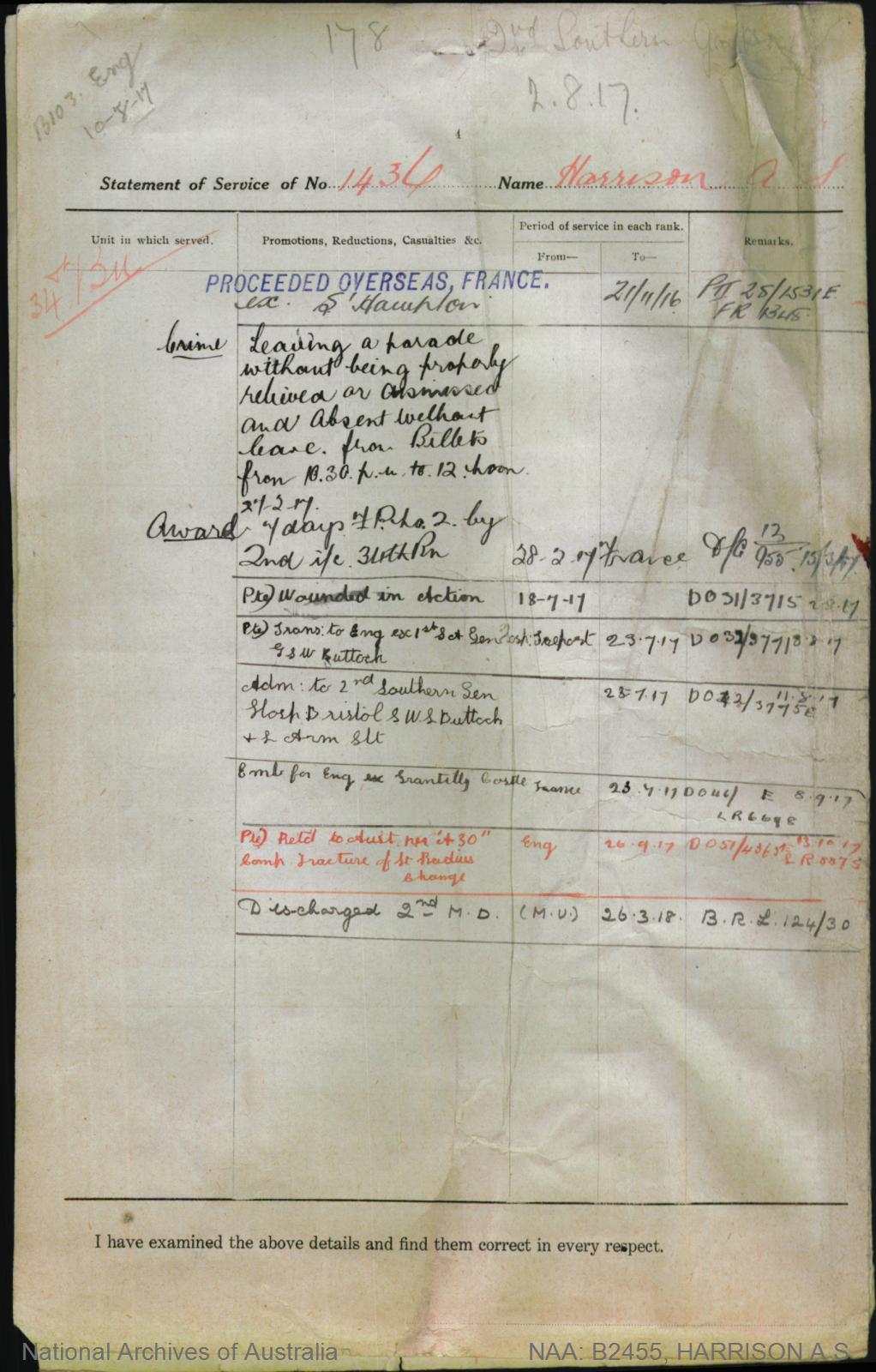
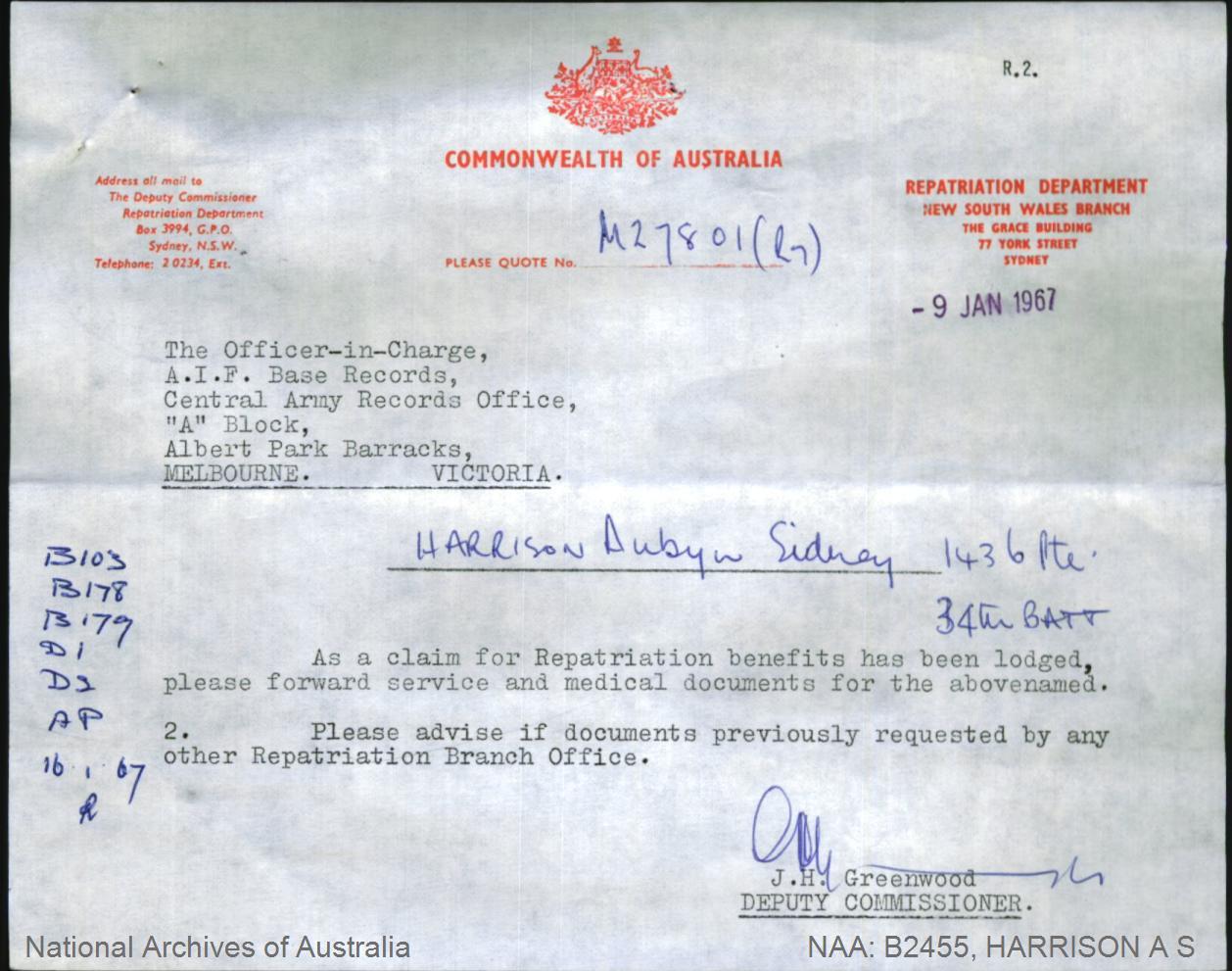

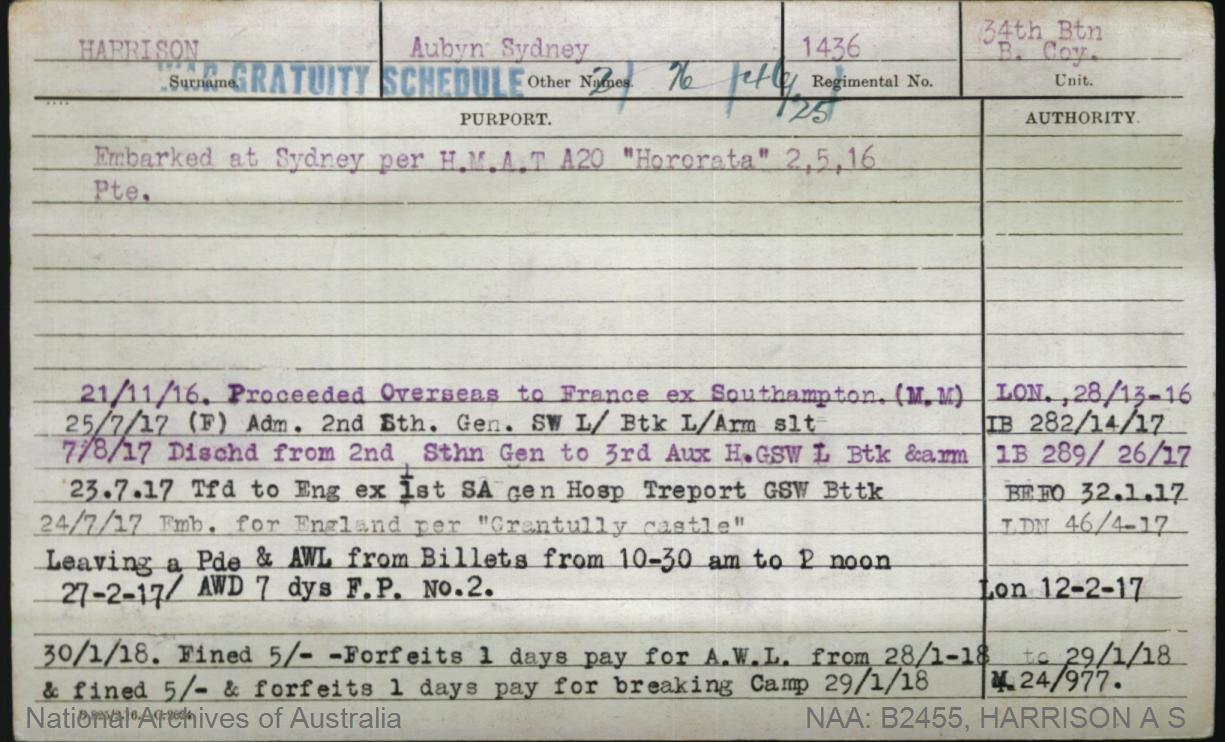

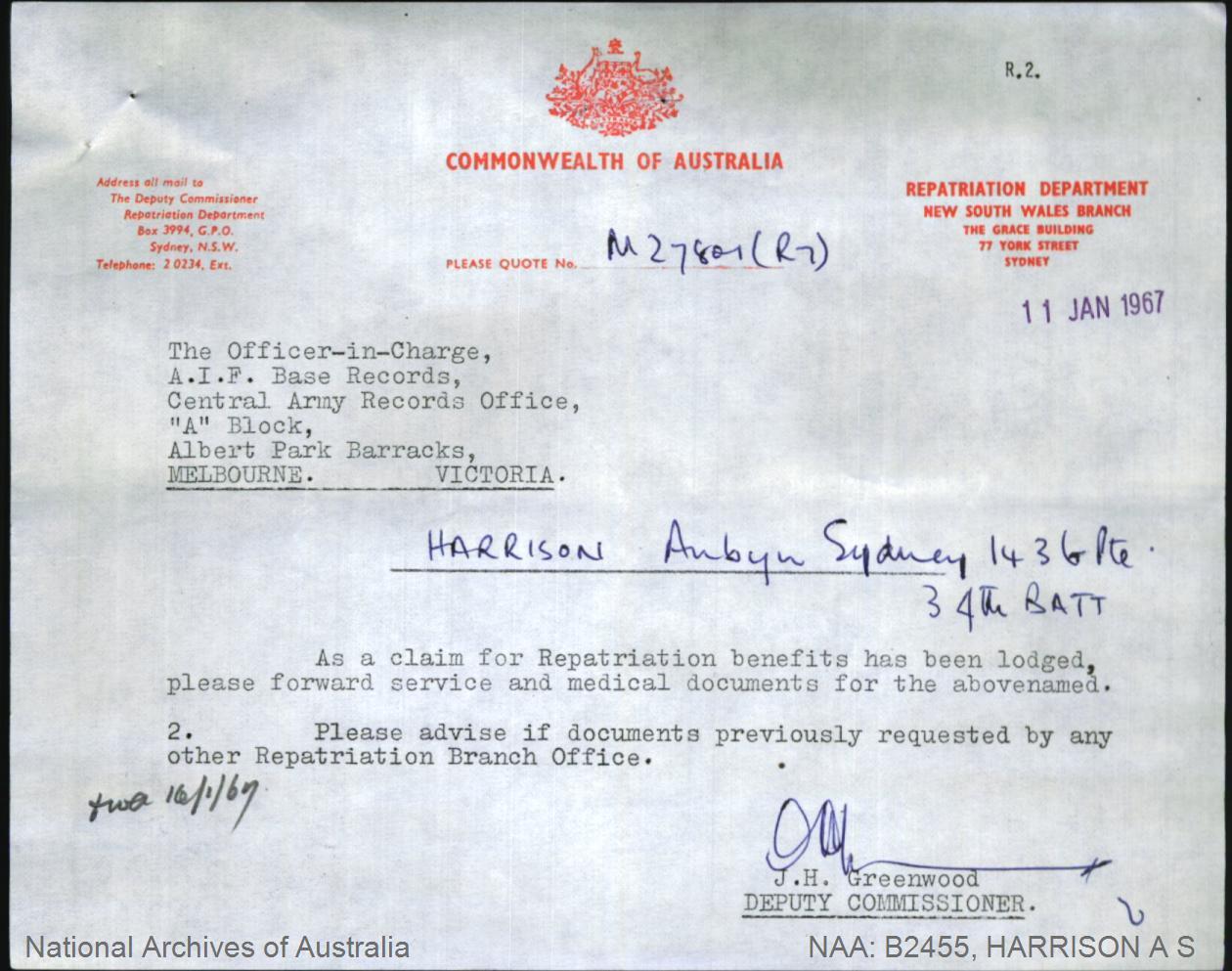

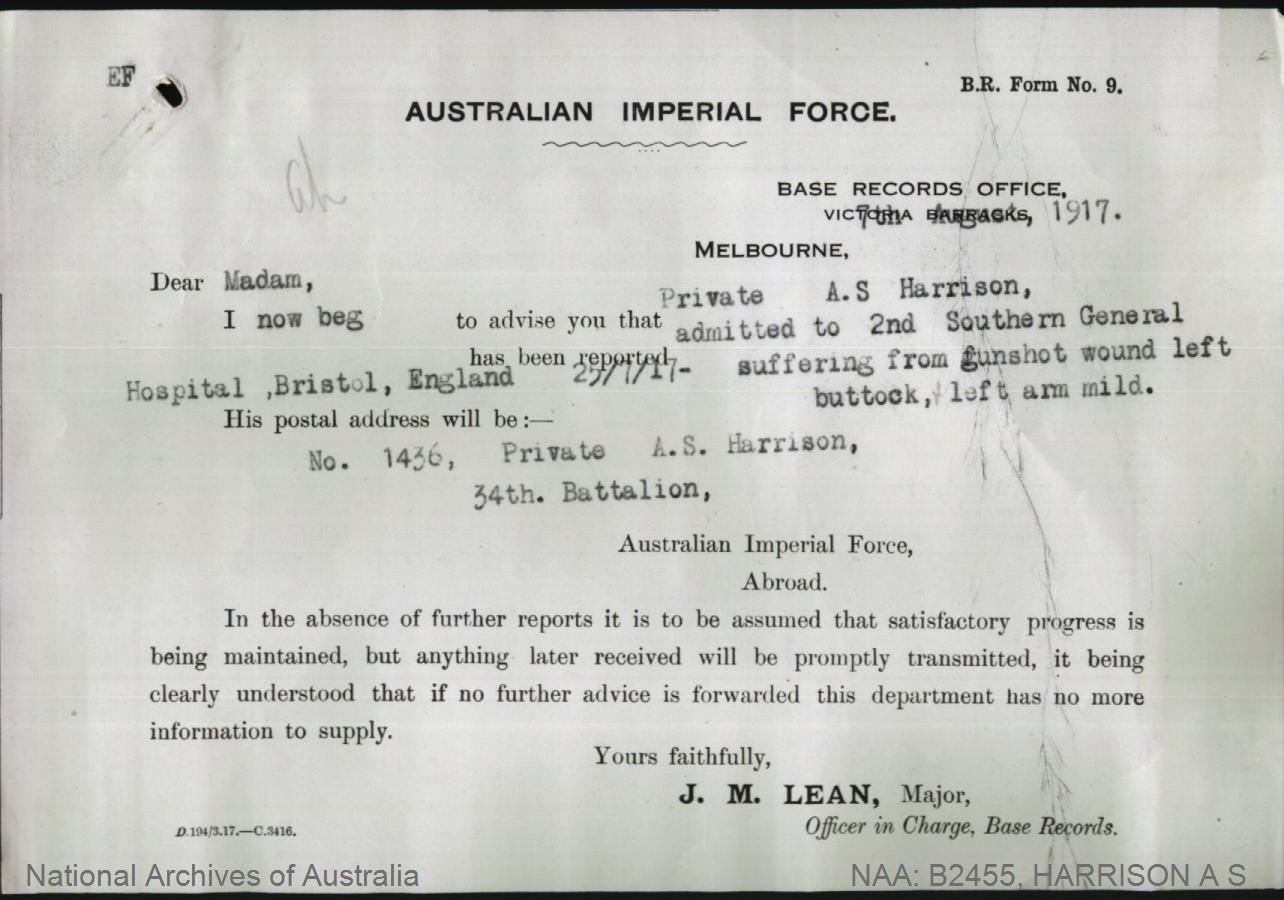
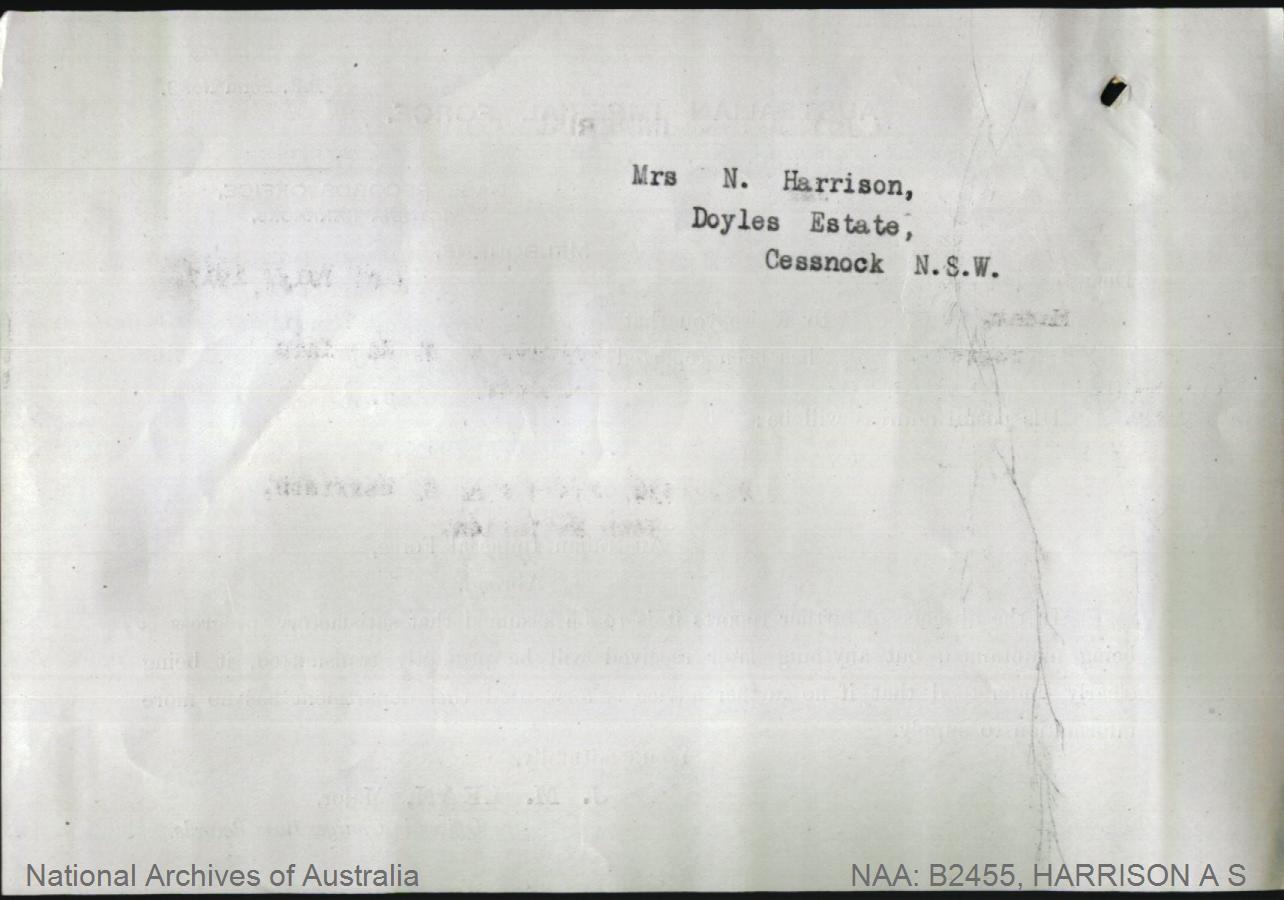
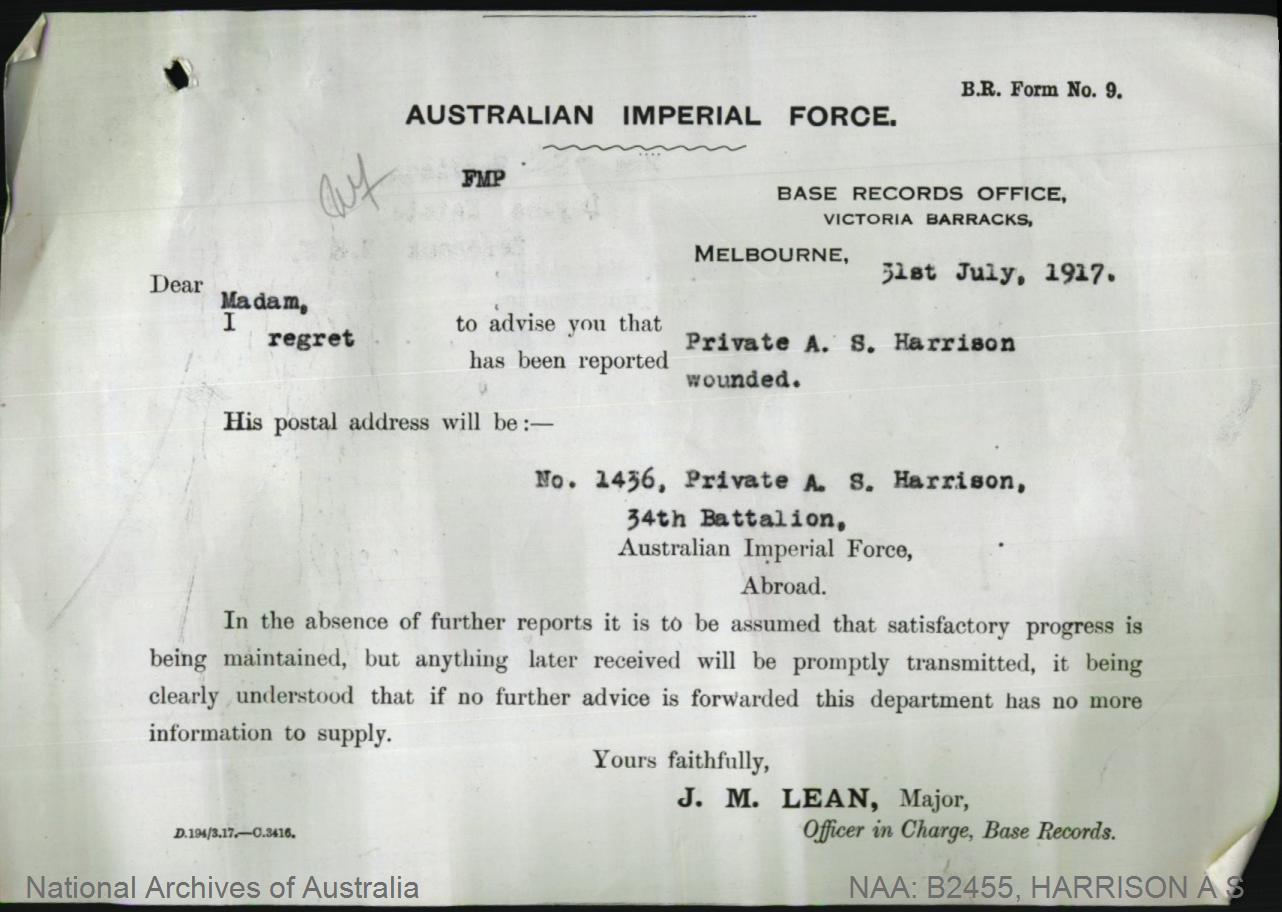
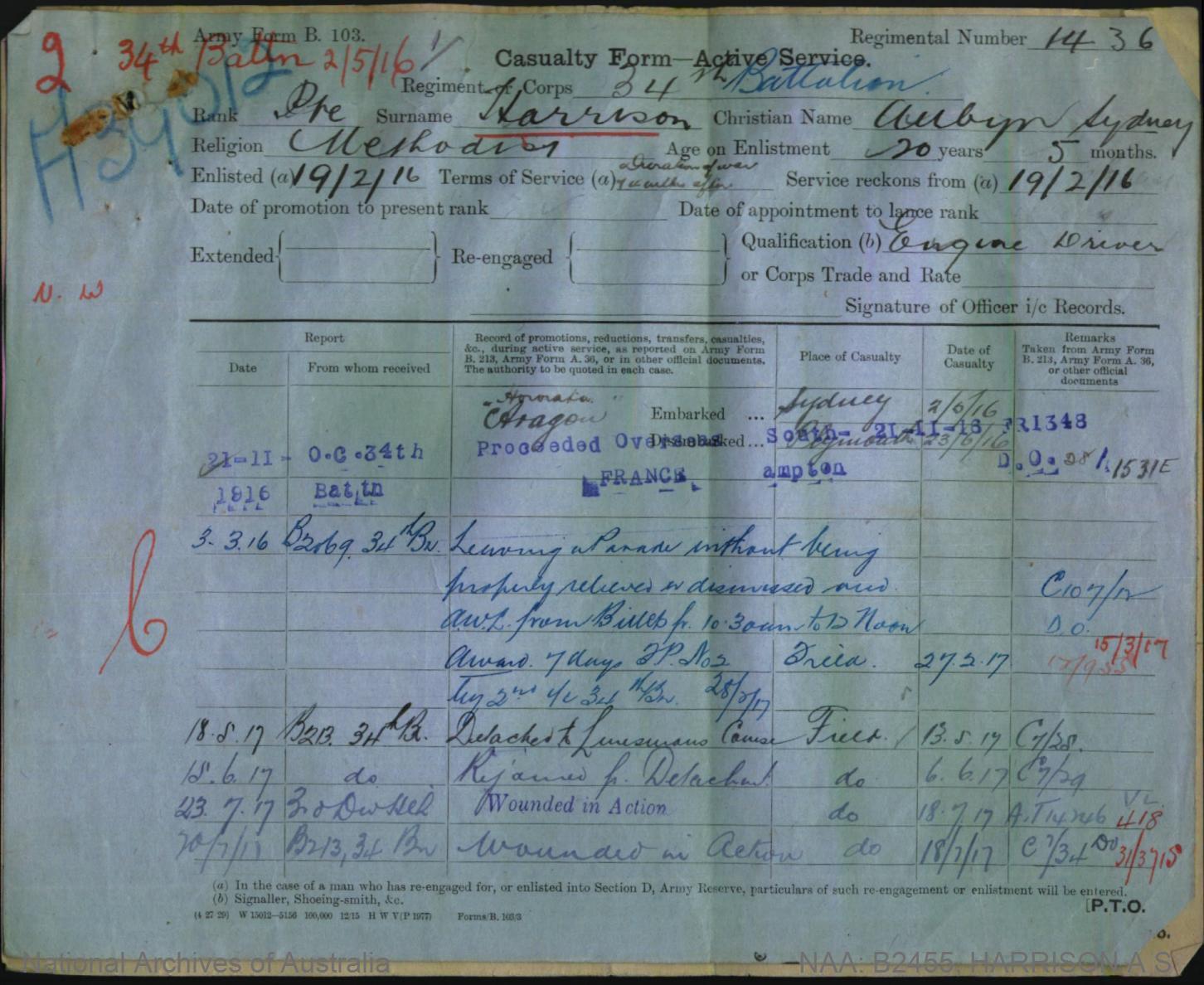
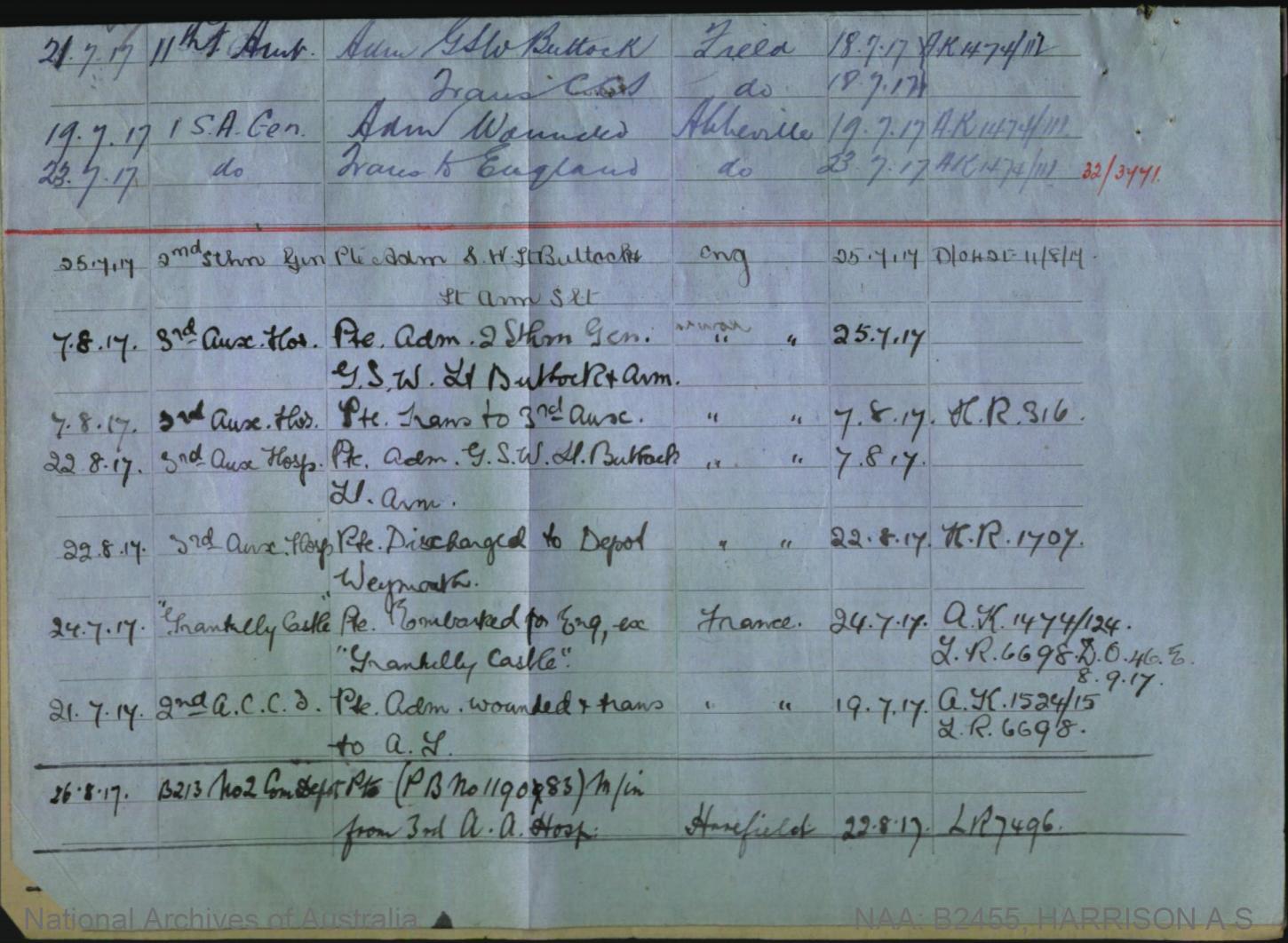
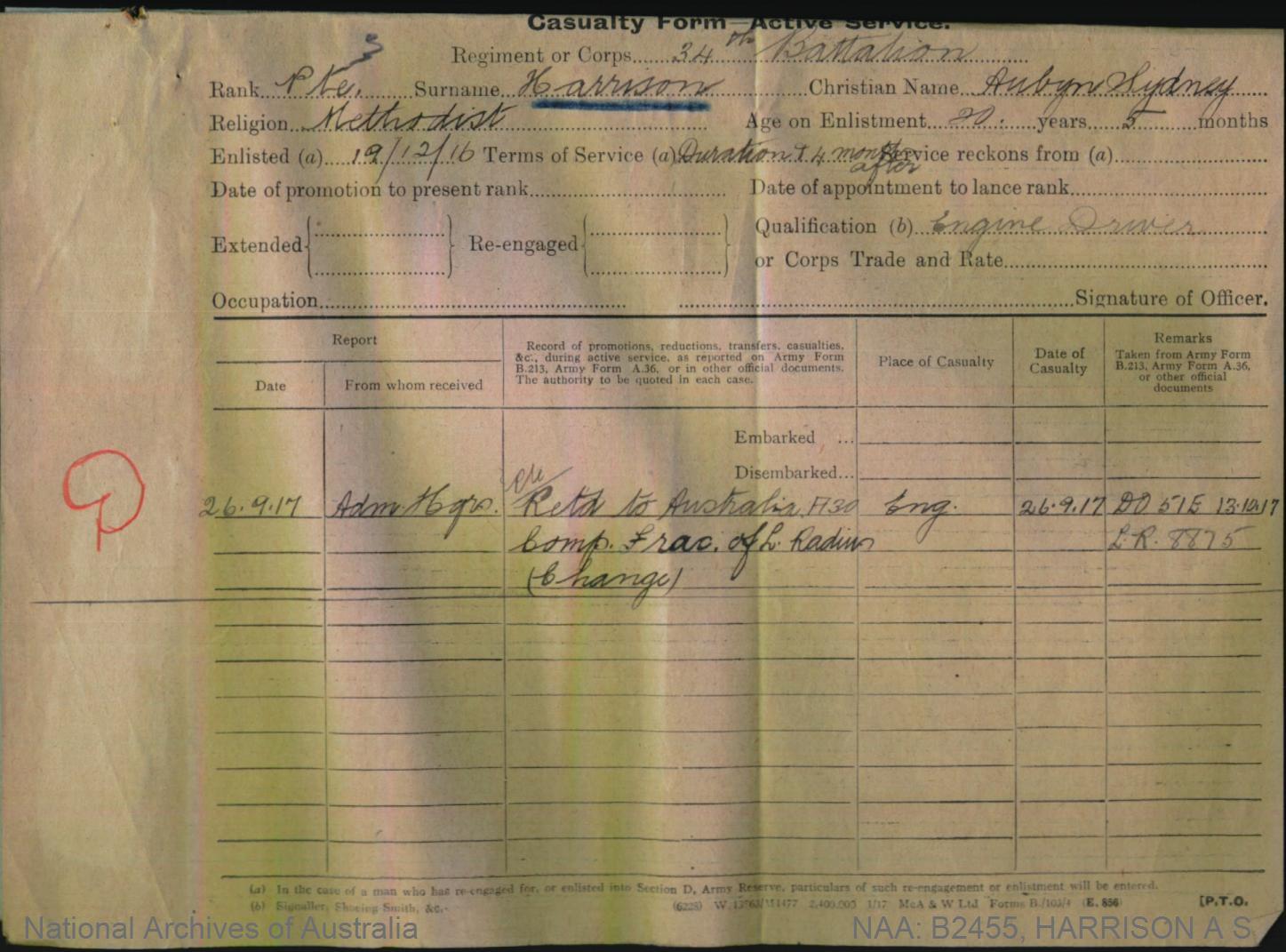
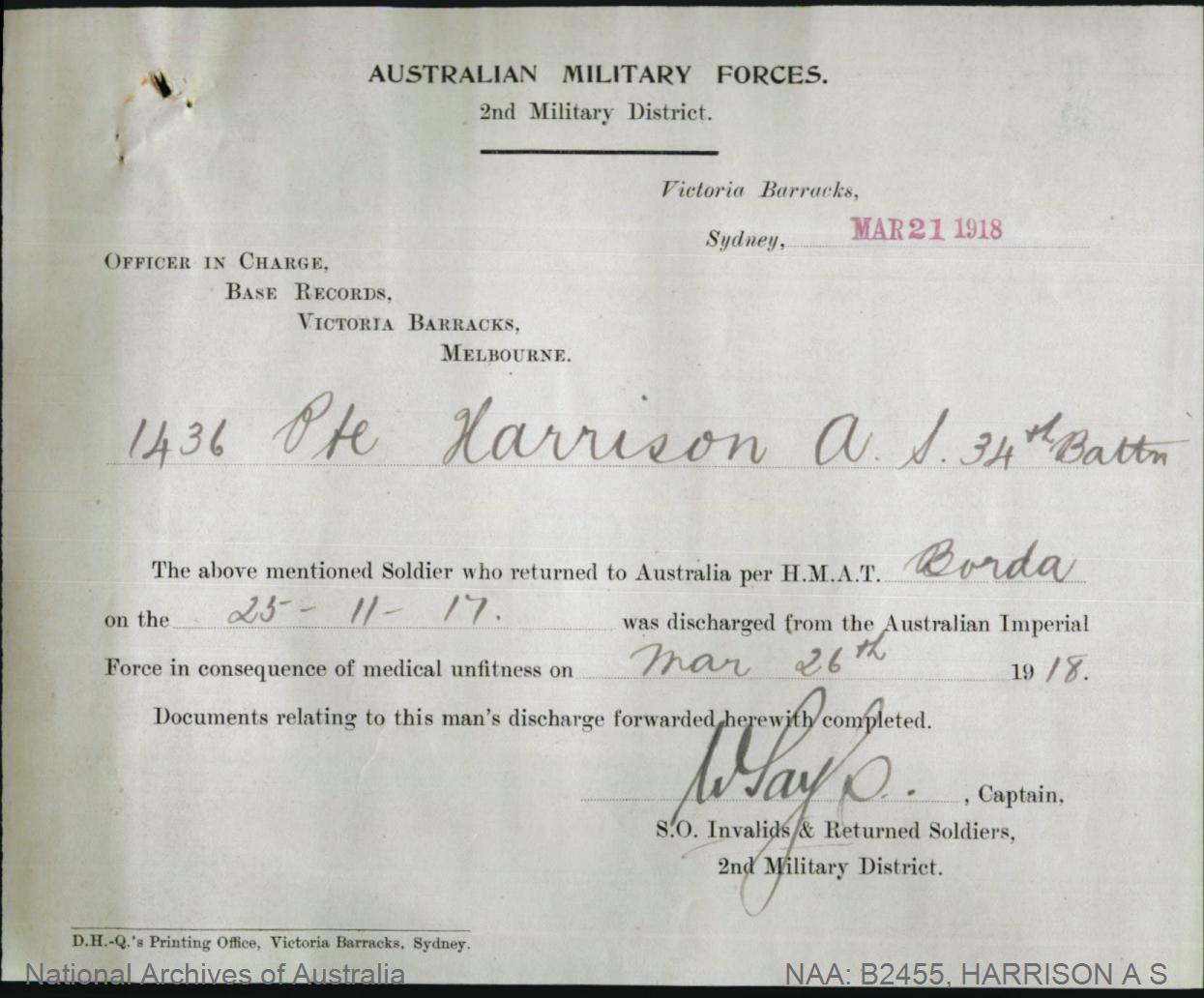
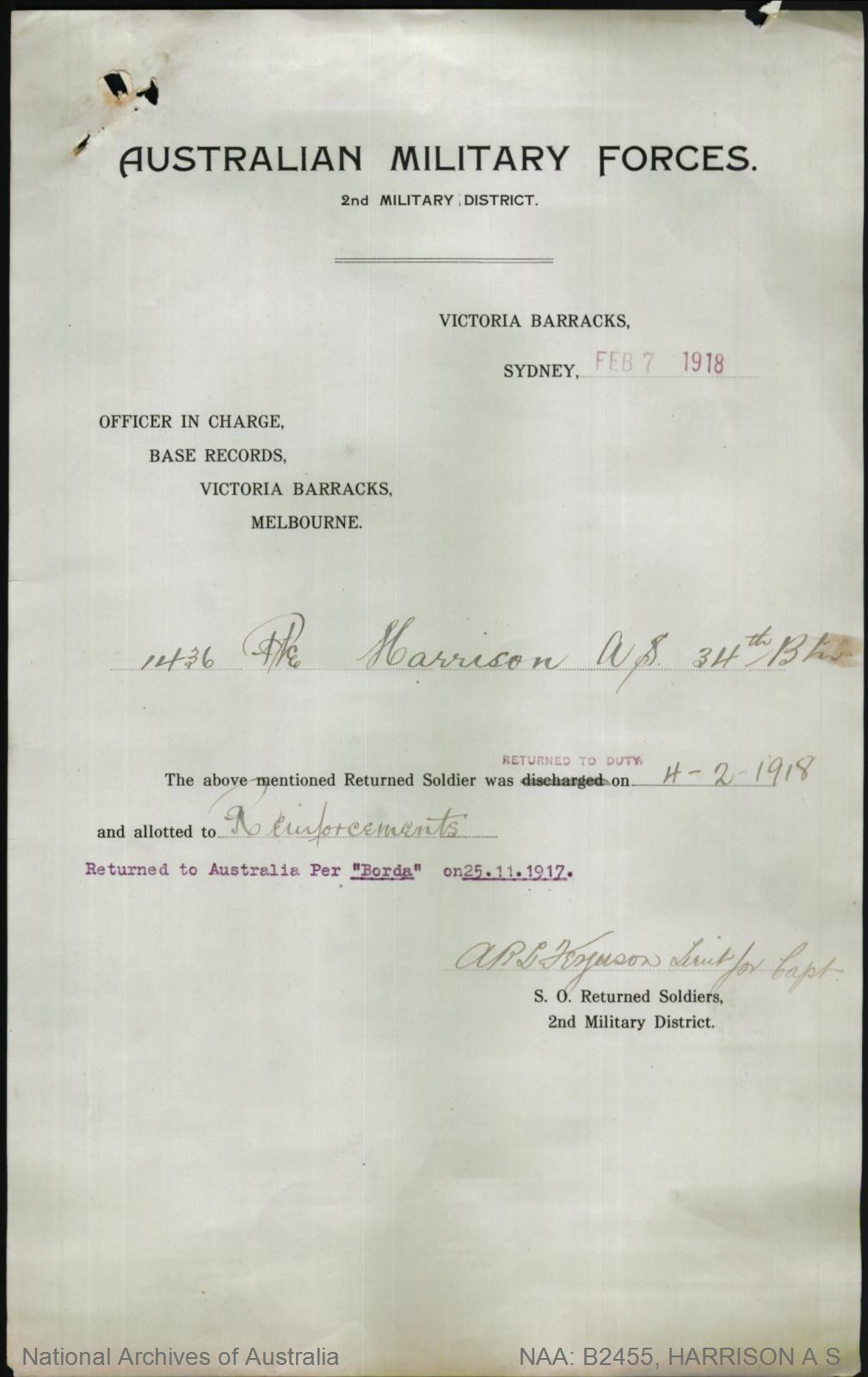


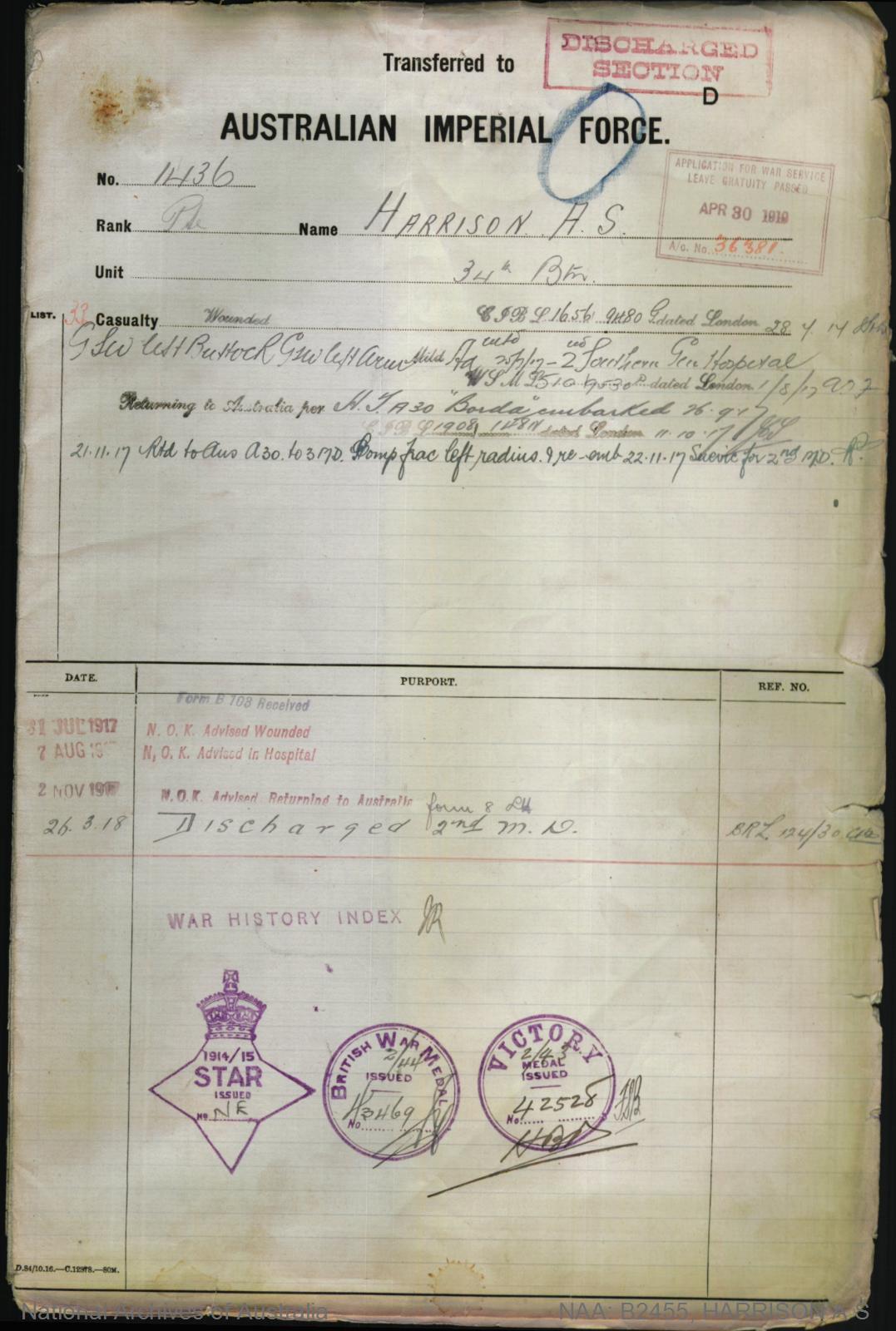
Military Records. Concentration Camp Guard.

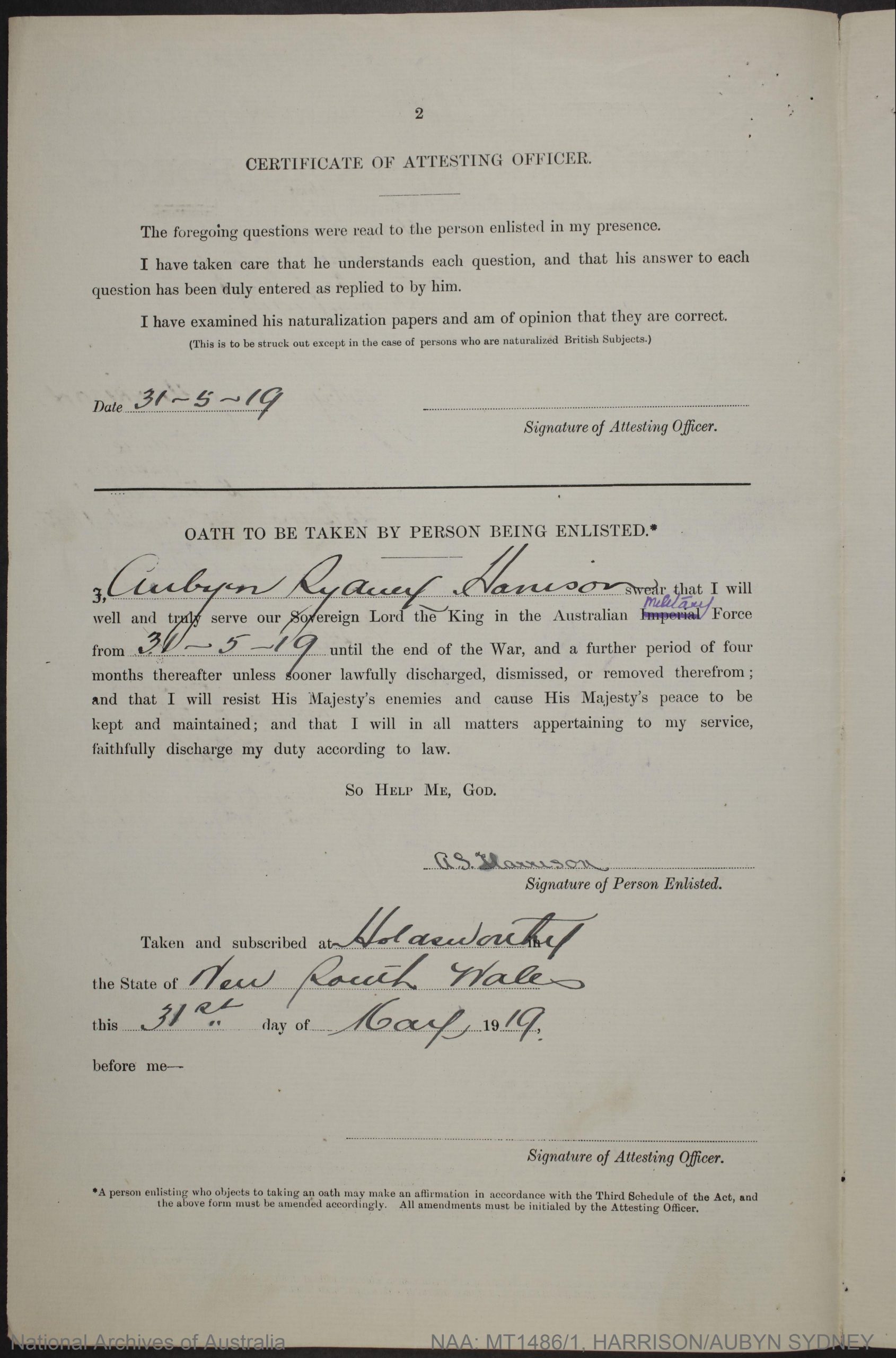
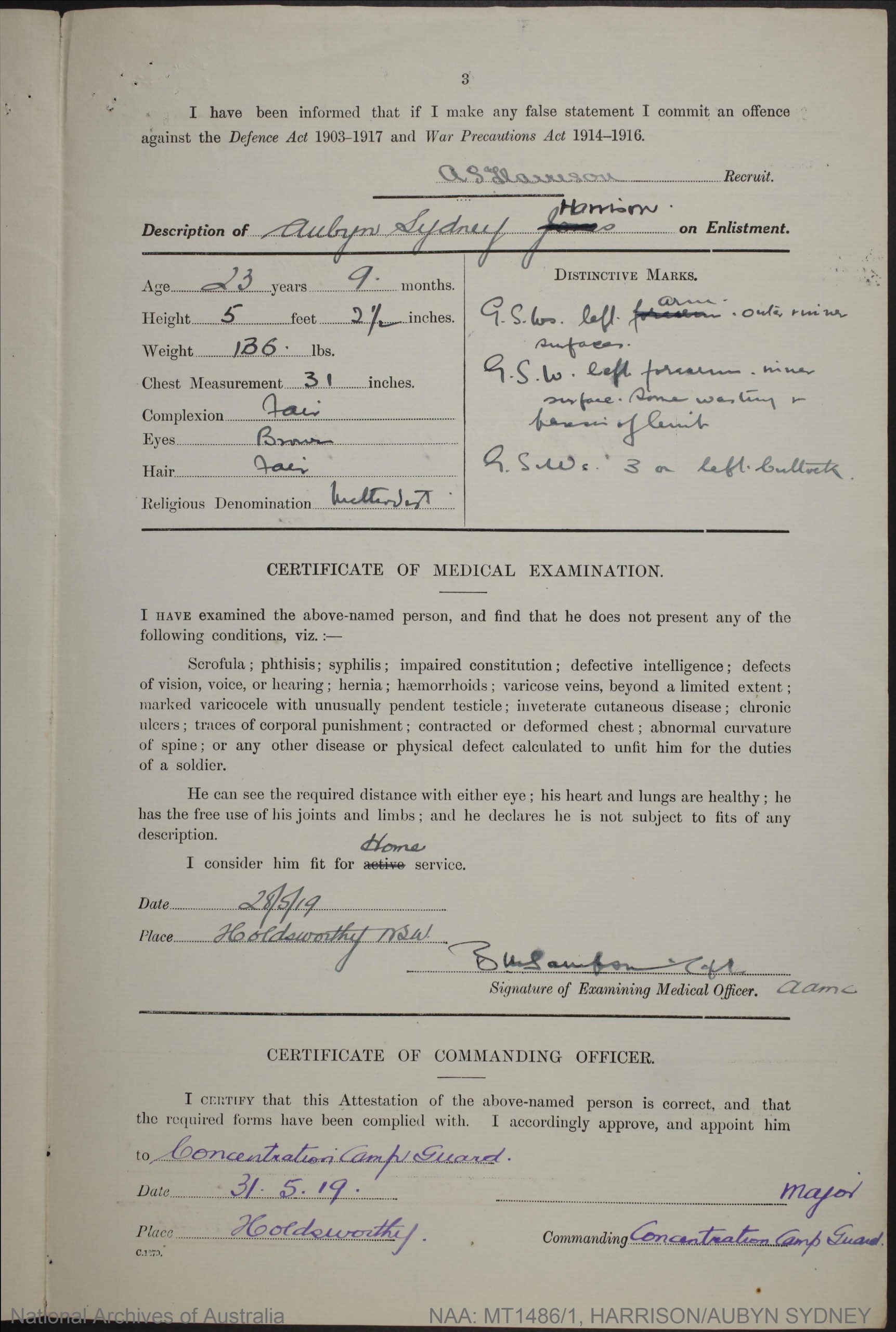
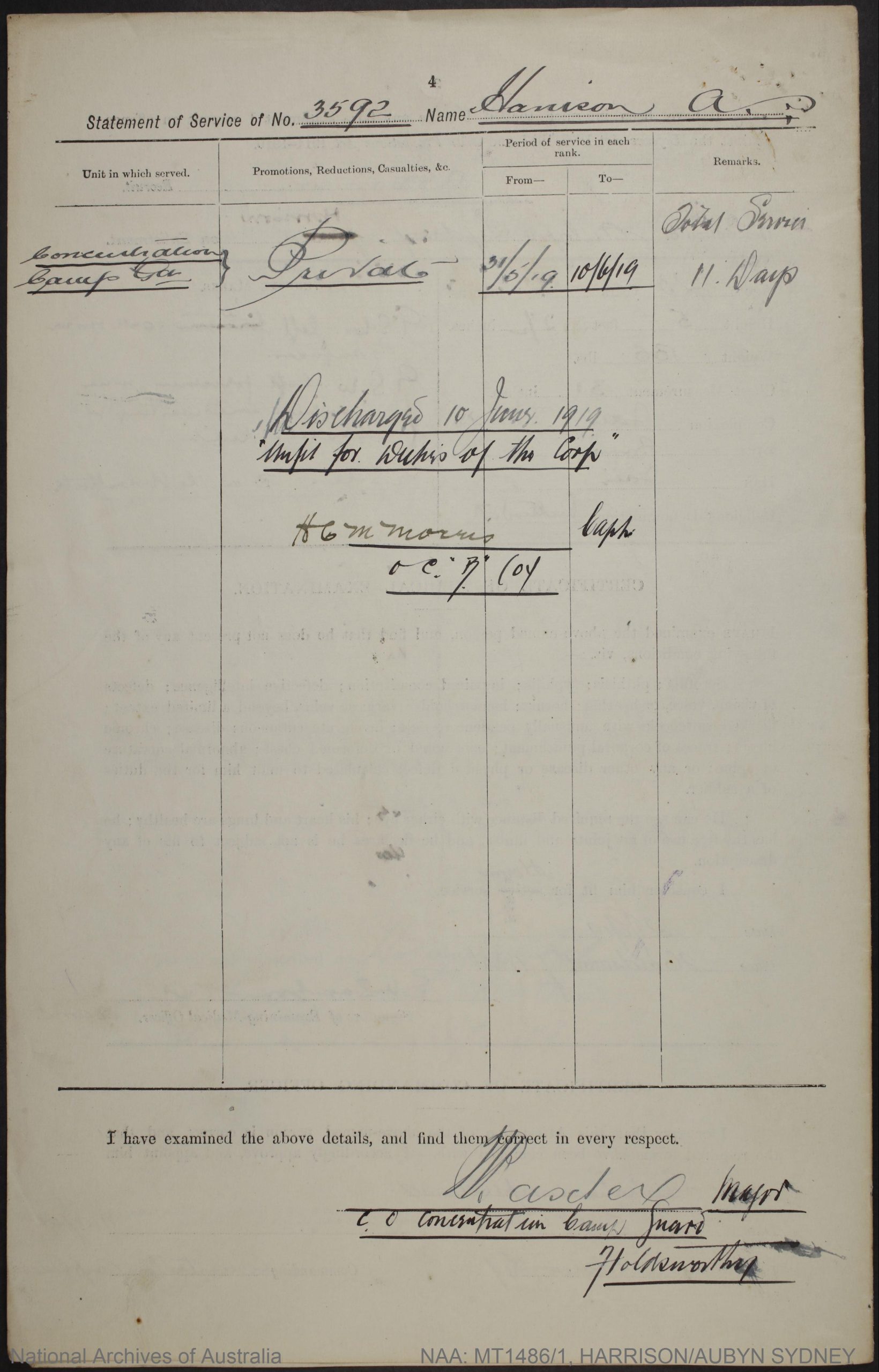
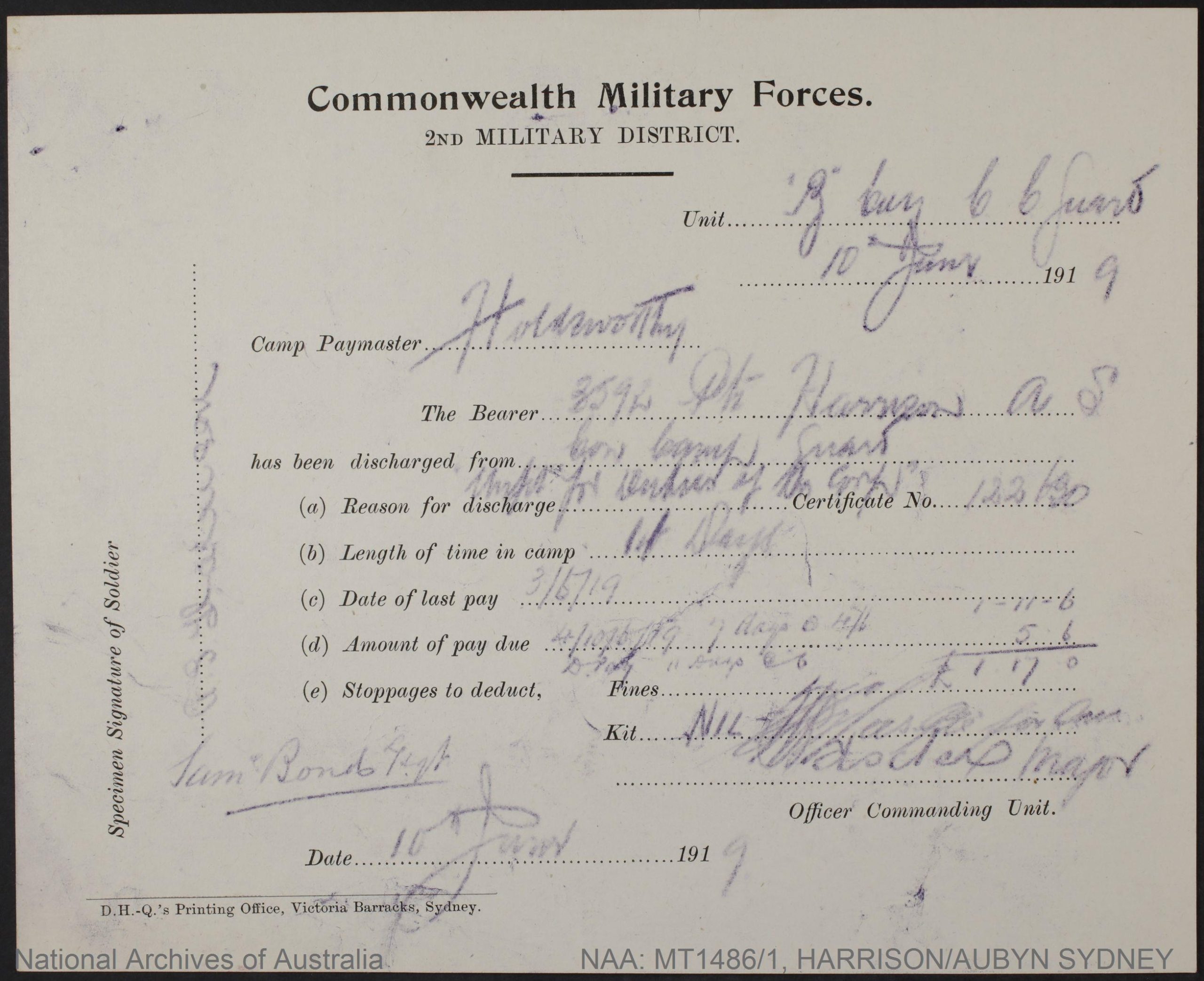
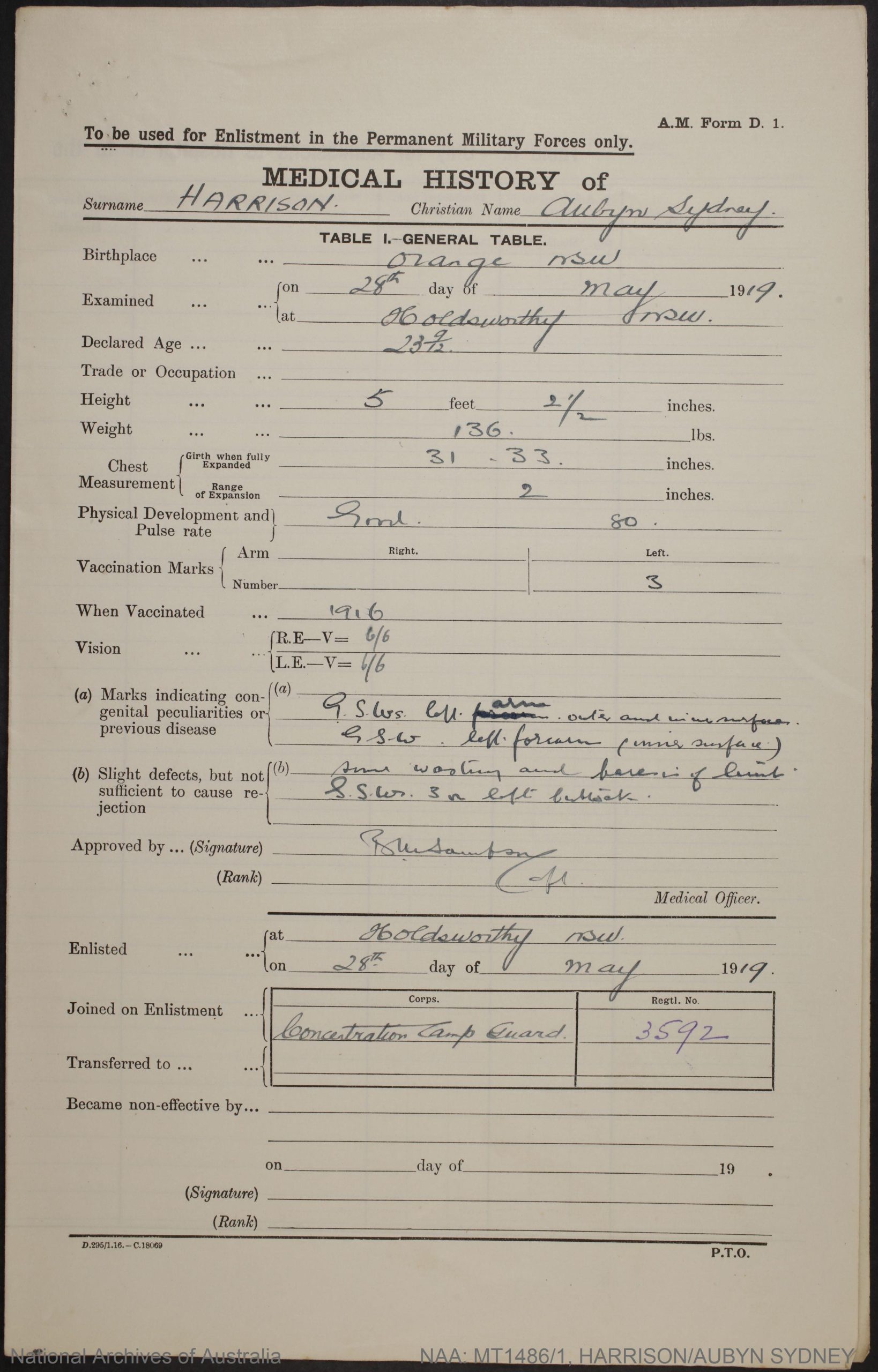
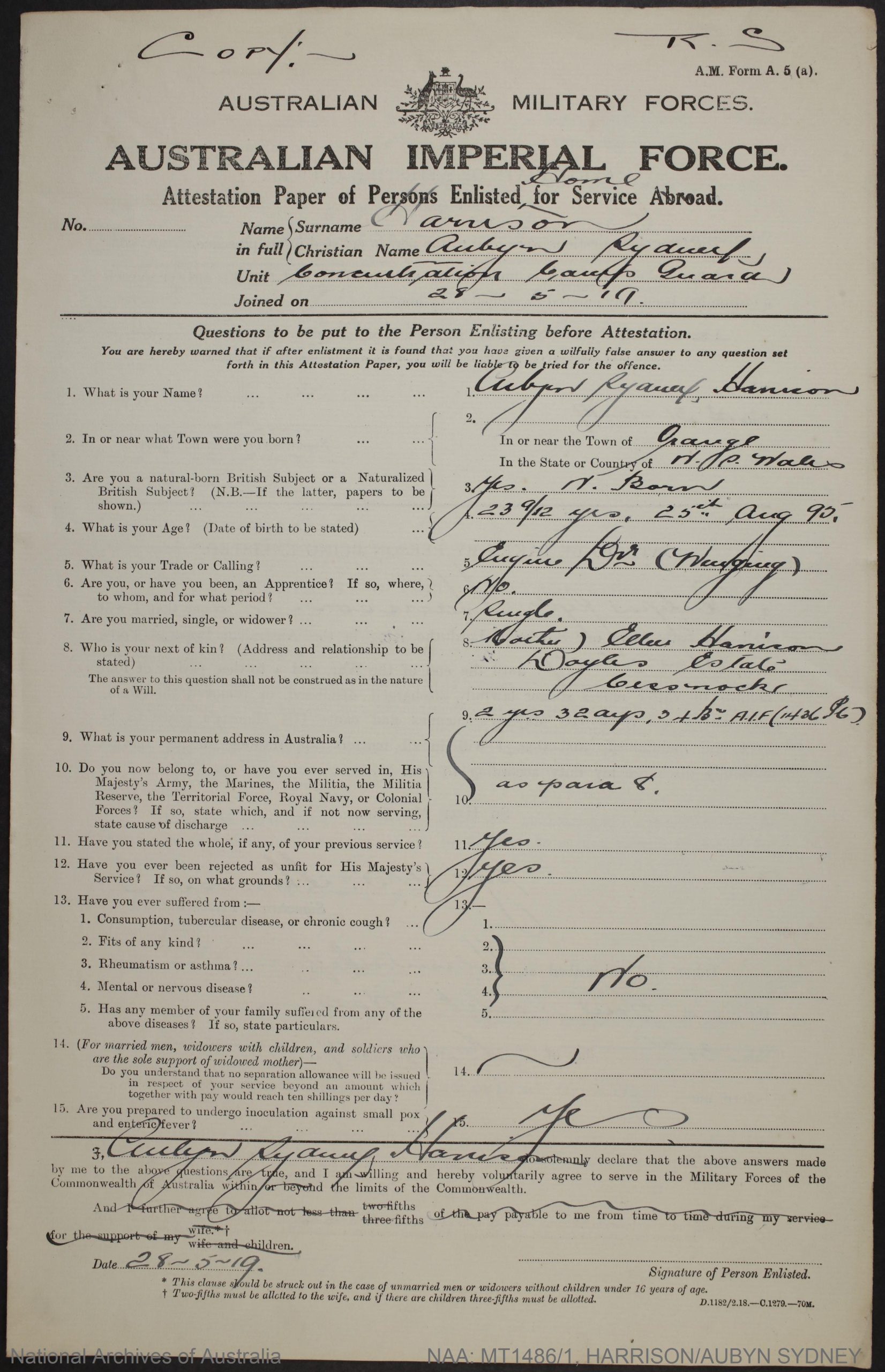
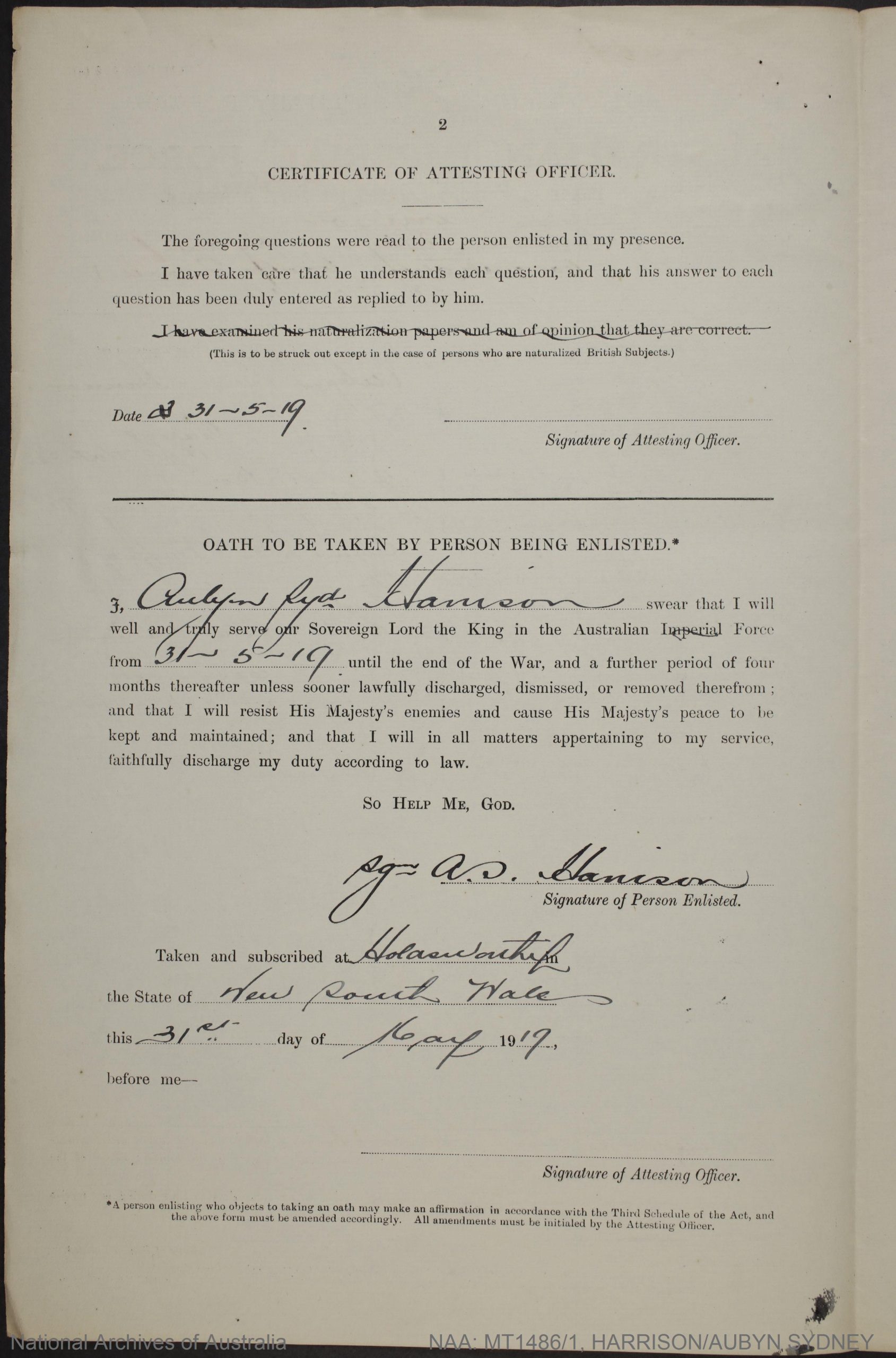
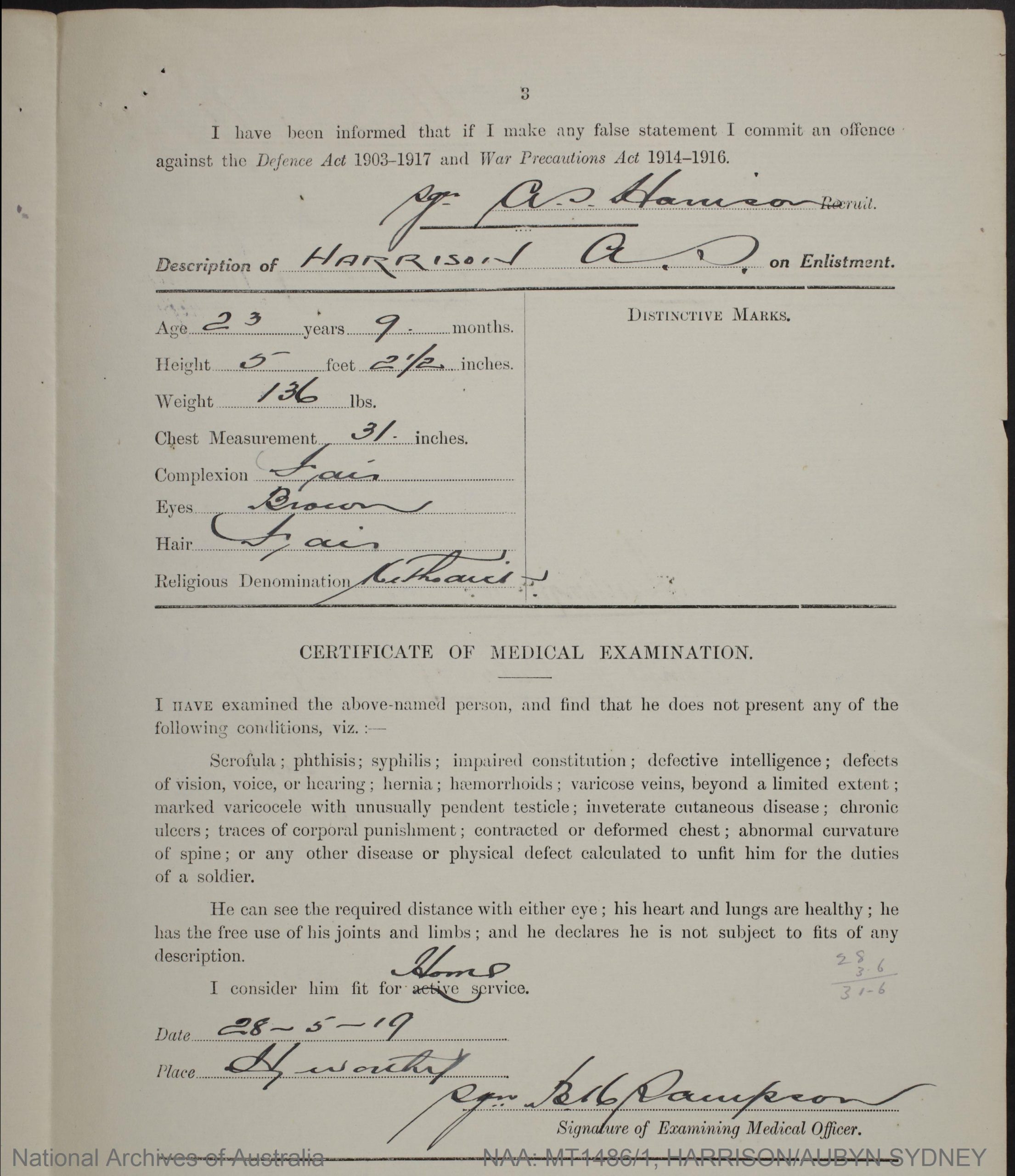

© Commonwealth of Australia (National Archives of Australia)
Under Construction: 18/08/2021-22/02/2024.
